Tips on How to Visit Bracciano Castle (Castello Odescalchi)
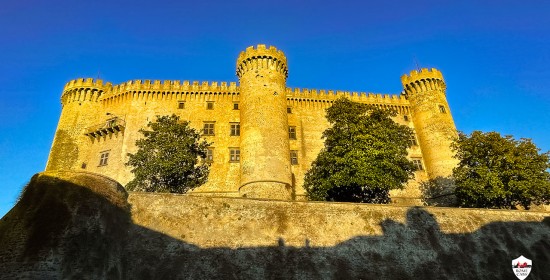
Buongiorno and welcome to Stefano's RomeCabs! This Guide is designed to complement our Rome Countryside tours, Pre Cruise Tours, Civitavecchia Shore Excursions, and Civitavecchia Post Cruise Tours that include visits to Bracciano Castle (Castello Odescalchi di Bracciano):
- Rome Town & Country Tour / Post Cruise Rome Town and Country
- Medieval Magic Countryside Tour / Post Cruise Medieval Magic Tour
- Countryside Splendor Tour / Post Cruise Countryside Splendor from Civitavecchia
- Pre-Cruise Rome Countryside Tour
In this blog, we will share with you what to see when you visit Bracciano Castle as we take you through the rooms and places recommended by the castle complementing each stop with photos and historical information that delves deeper into the intriguing lives of Bracciano's two influential families of the Italian Renaissance: the Orsini and Odescalchi.
Brief History of Castello Orsini-Odescalchi
Boasting more than five centuries of history, the castle stands as a commanding presence over the picturesque town of Bracciano and its stunning lake.
The history of this castle's ownership dates back to the 1470s when Napoleone Orsini embarked on a project to renovate and expand the ancient fortress, which they had acquired. This fortress had previously been under the rule of the Vico prefects, a family that held significant influence over the Tuscia region during the late Middle Ages.
At the time, Napoleone Orsini was the brother of Cardinal Latino Orsini, who served as the chamberlain of Pope Sixtus IV della Rovere.
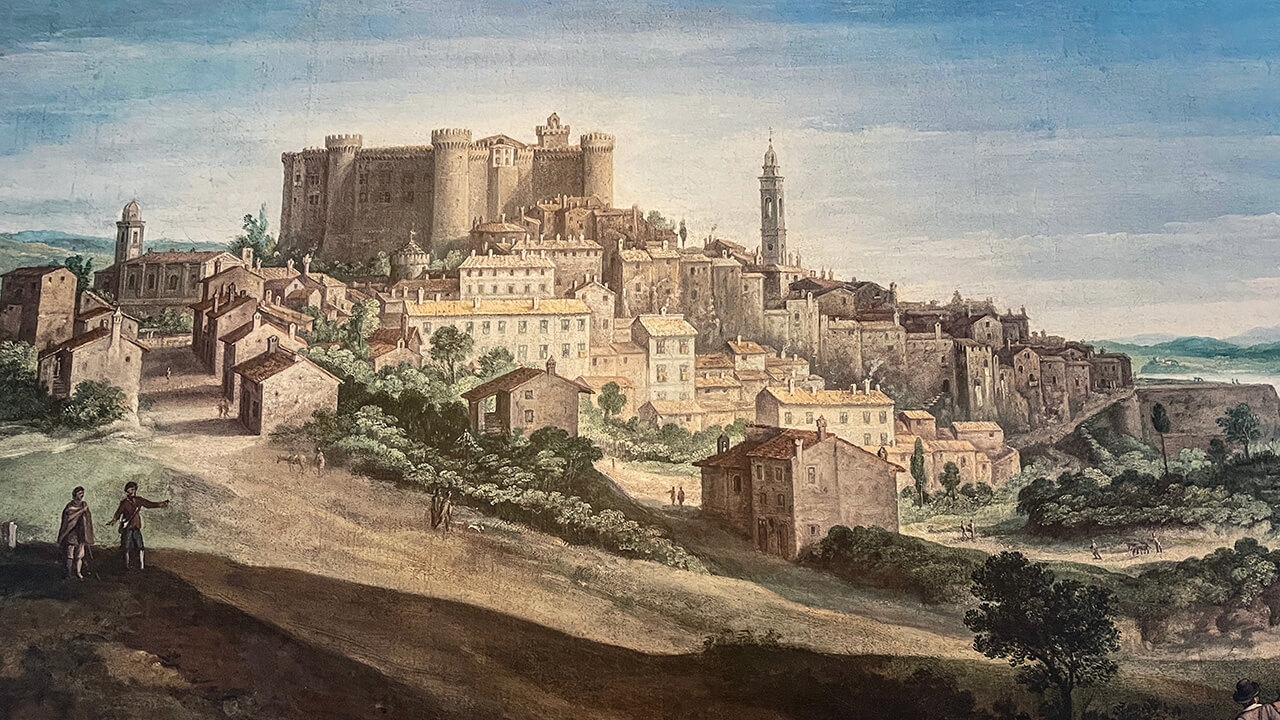
The Orsini family retained ownership of the castle until the late 17th century when the family lineage came to an end. At that point, the castle changed hands and came under the ownership of another prominent family, the Odescalchi, who remain the current owners of the castle. The Odescalchi family hails from the Lombardy region and can trace their lineage back to the era of Charlemagne.
The formidable defensive walls were masterminded by Francesco di Giorgio Martini, while the courtyard of honor was designed by Giovannino de' Dolci, a Florentine architect deeply involved in the construction of the Sistine Chapel.
The Castle’s transformation was completed in 1485 under the supervision of Napoleone’s son, Gentile Virginio.
Orsini’s endeavors transformed the castle into a remarkable example of Renaissance military architecture. When Pope Sixtus IV sought refuge in Bracciano, fleeing the plague that had engulfed Rome, he noted that the castle surpassed even the grandeur of the papal palace in the Vatican.
What to See when you Visit Bracciano Castle
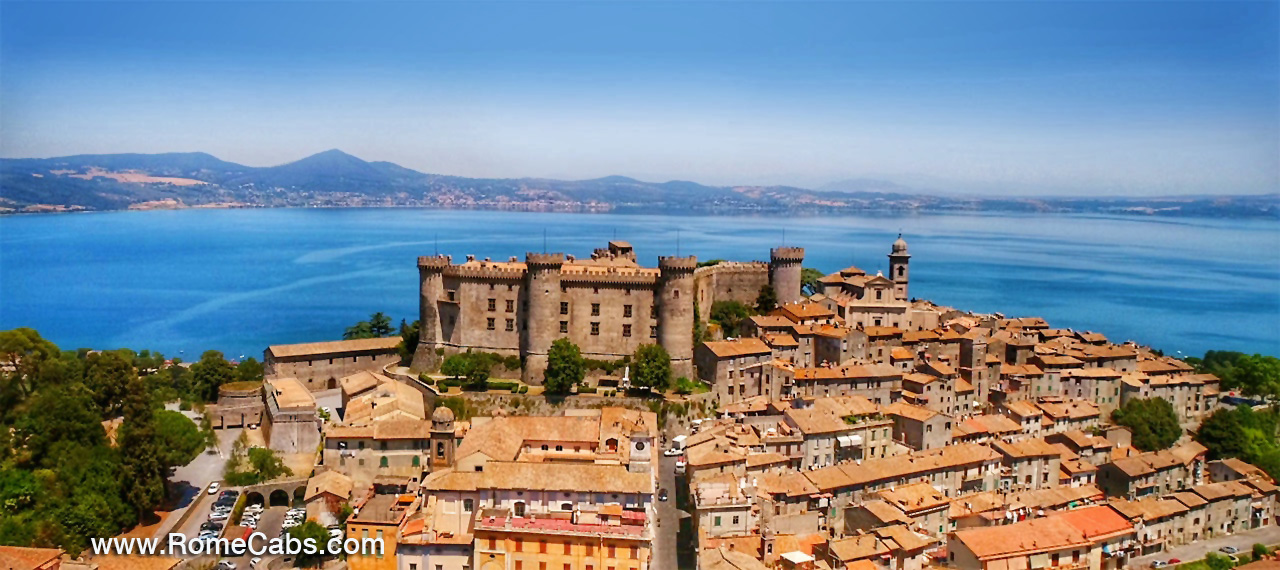
Arch of Paolo Giordano Orsini
We begin our journey through Bracciano Castle (Castello Orsini-Odescalchi) at the main entrance.
As you pass through the grand arched entrance, you'll step into the historic footsteps of some of Europe's most renowned figures, including kings, queens, popes, military leaders, dukes, knights, and noble ladies, dating back to the early 15th century.
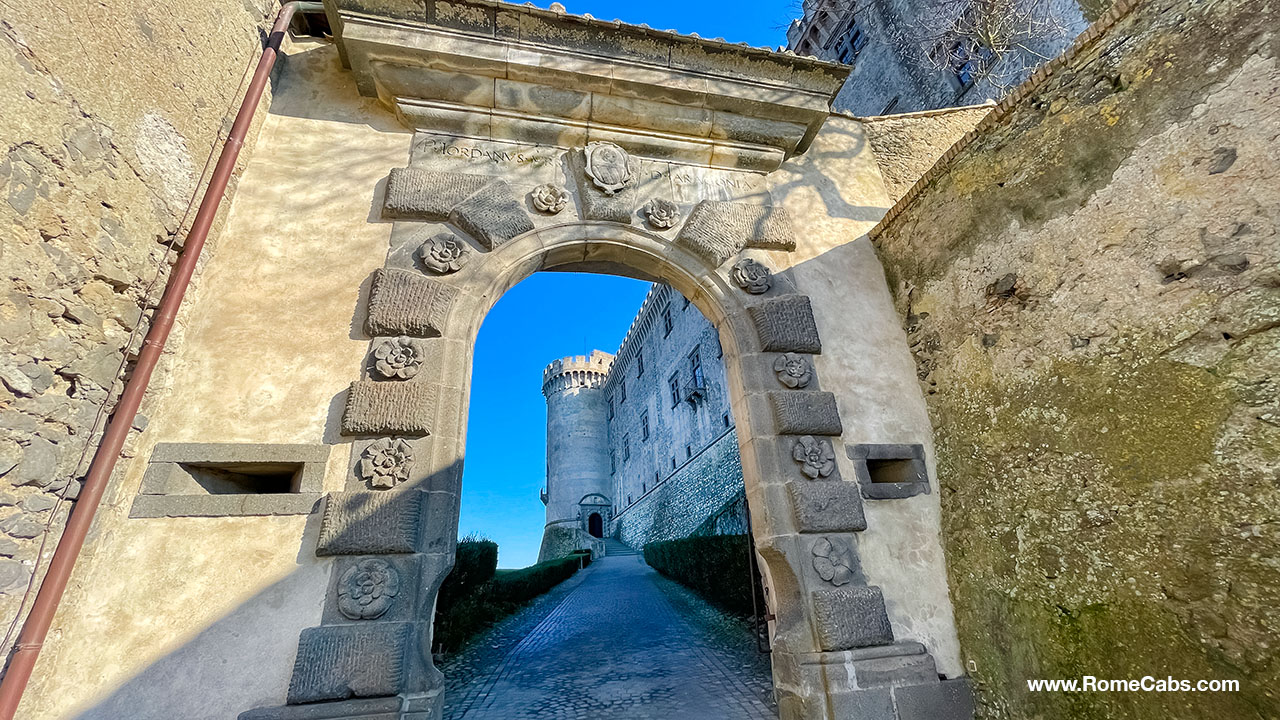
Above this imposing arch, meticulously carved in stone by Jacopo del Duca, a student of Michelangelo, you'll find the name of one of the most illustrious members of the Orsini family: Paolo Giordano Orsini d'Aragona.
Paolo Giordano Orsini, heir of the Orsini family, was born on January 1, 1541, boasting the distinction of being the grandson of two popes.
As you enter through the arched gateway, follow the path leading you alongside the castle towards the grand entrance. On your right, you'll see one side of the castle, while on your left, a lush green lawn extends, offering a view of the tranquil blue waters of Lake Bracciano beyond.
Enter through the Jacopo del Duca Door
Now, enter through the Jacopo del Duca Door into the Castle's vestibule where your tour will begin.
Upon entering the castle through the magnificent Jacopo del Duca Door, you'll notice a Latin inscription above the portal that reads:
"I was founded by Napoleone Orsini, captain of the church. I defend the good and reject the guilty".
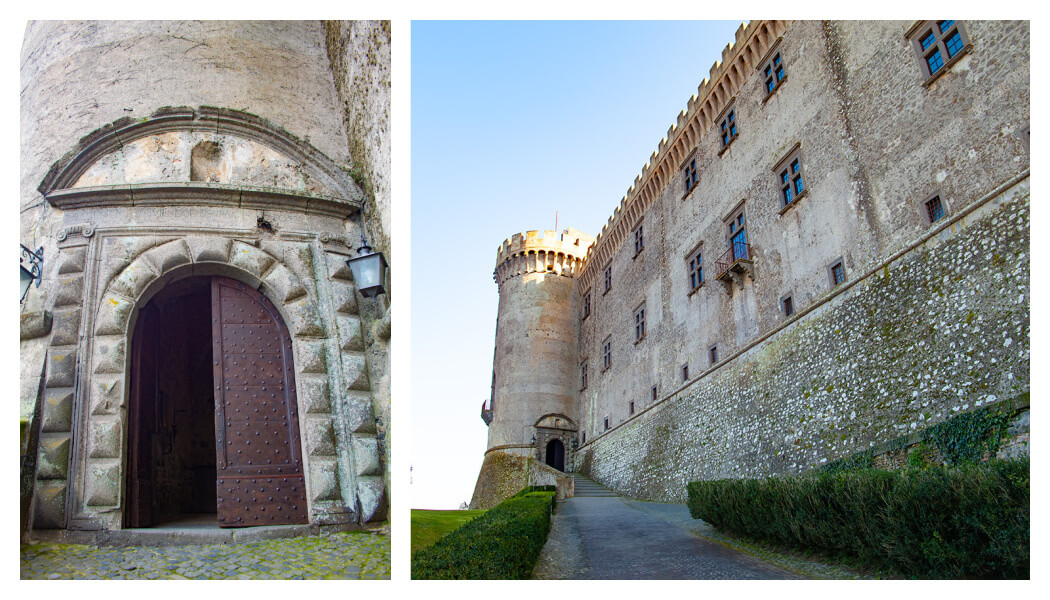
Upon entering through the grand doors, you'll find yourself in the vestibule, which served as a link between the upper and lower courts of the castle. At the base of the monumental staircase, you can't miss a symbol strongly associated with the Orsini family: a statue of a she-bear holding a coat of arms bearing the emblem of the Orsini of Bracciano, which also includes a rose.
This emblem cleverly plays on the Italian words "Orsa" (she-bear) and "Rosa" (rose). The Orsini lineage claims descent from a certain "Ursus" who, like Remus and Romulus, was said to have been nurtured by a she-bear. Astrologers also assigned the Orsini a celestial place among the stars: Ursa Major (the Great Bear).
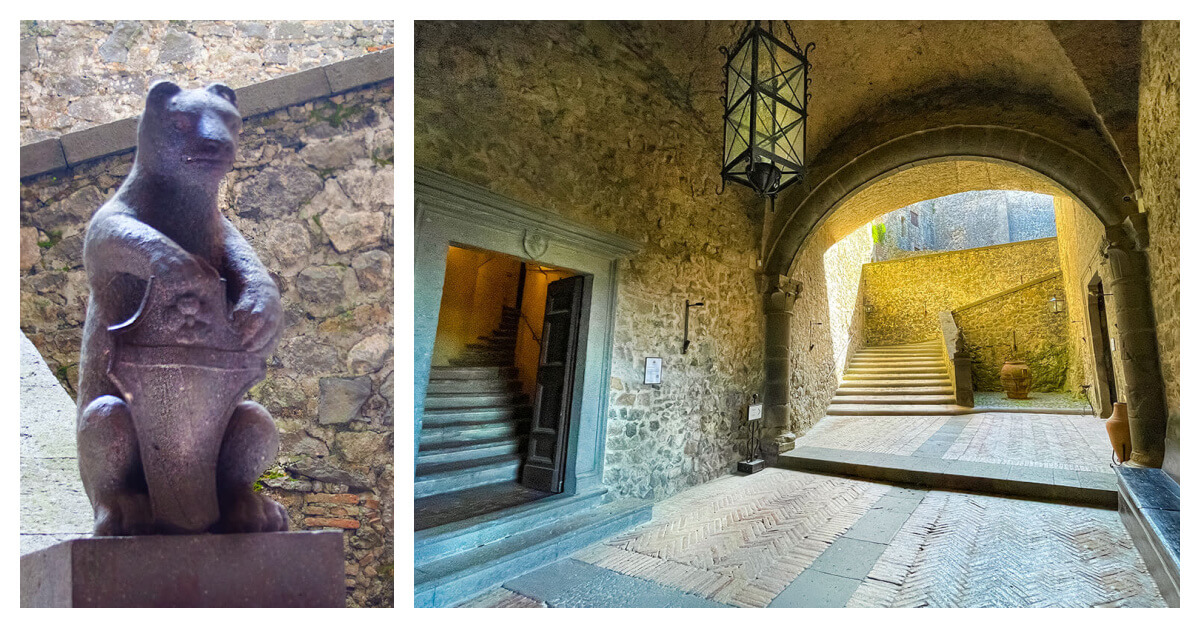
The Armory of Bracciano Castle
To your right, you'll find the arched entrance to the armory, a reminder of the castle's perpetual readiness for both defense and warfare.
Crowned by a robust arch and flanked by stone pillars, this door grants access to a sequence of chambers, some of which are hewn into the cliffside and illuminated by windows. These spaces were originally designed to serve as the castle's guardhouse and garrison, housing weaponry and ammunition stores. The final room in this sequence also features an access point to a drainage tunnel, purposefully built to collect rainwater that flowed into the courtyard.
The castle was fortified with state-of-the-art arms of the time, including firearms and artillery to defend against enemy assaults. In 1496, during the intense conflict between the Orsini family, Pope Alexander VI (Rodrigo Borgia), and the King of Naples, these defenses were put to the test. This tumultuous period saw perilous political alliances, betrayal, the siege of Bracciano Castle, and the tragic downfall of Gentil Virginio Orsini.
- READ MORE about the Attack on Bracciano Castle, the Demise of Gentil Virginio Orsini and the bravery of Bartolomea Orsini - the "Lady Warrior"- on our blog: Powerful Renaissance Women of Bracciano Castle: Bartolomea Orsini, Felice delle Rovere, Isabella de Medici
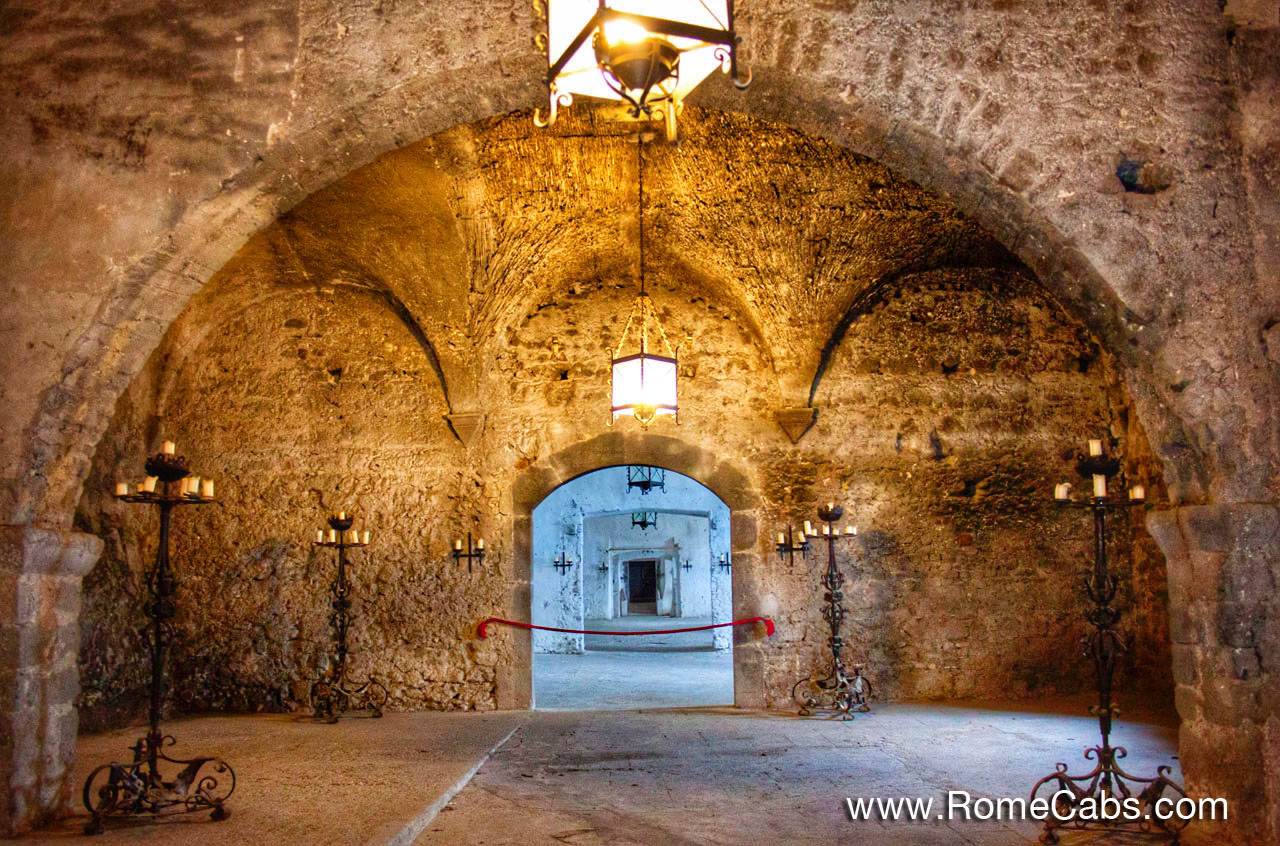
Climb the Grand Staircase to the Court of Honor
As you proceed, ascend the grand staircase leading you to the Court of Honor.
The Court of Honor within Bracciano Castle forms a triangular expanse, evoking the architectural style of early Roman Renaissance citadels and creating a spacious square within the castle's confines. One side of this court features a wall adorned with two-story arcades, serving as a passage to Paolo Giordano's private apartments, which, unfortunately, remains off-limits to visitors.
The grand portal, exquisitely adorned in an ancient fashion, grants entry to the castle's noble floors and was the very place where the Orsini family received their distinguished guests.
It was here, in the spring of 1553, that the Orsini family negotiated with the Florentine ambassador of the Medici family to arrange the marriage of the young Paolo Giordano and Isabella de Medici, who were merely 12 and 11 years old at the time. This union was primarily driven by political motives, as the de Medicis sought to establish a significant connection to Rome.
The Medici-Orsini marriages had a history of bringing good fortune. The union of Lorenzo the Magnificent and Clarice Orsini resulted in ten children, one of whom became a pope (Giovanni de’ Medici who became Pope Leo X in 1513).
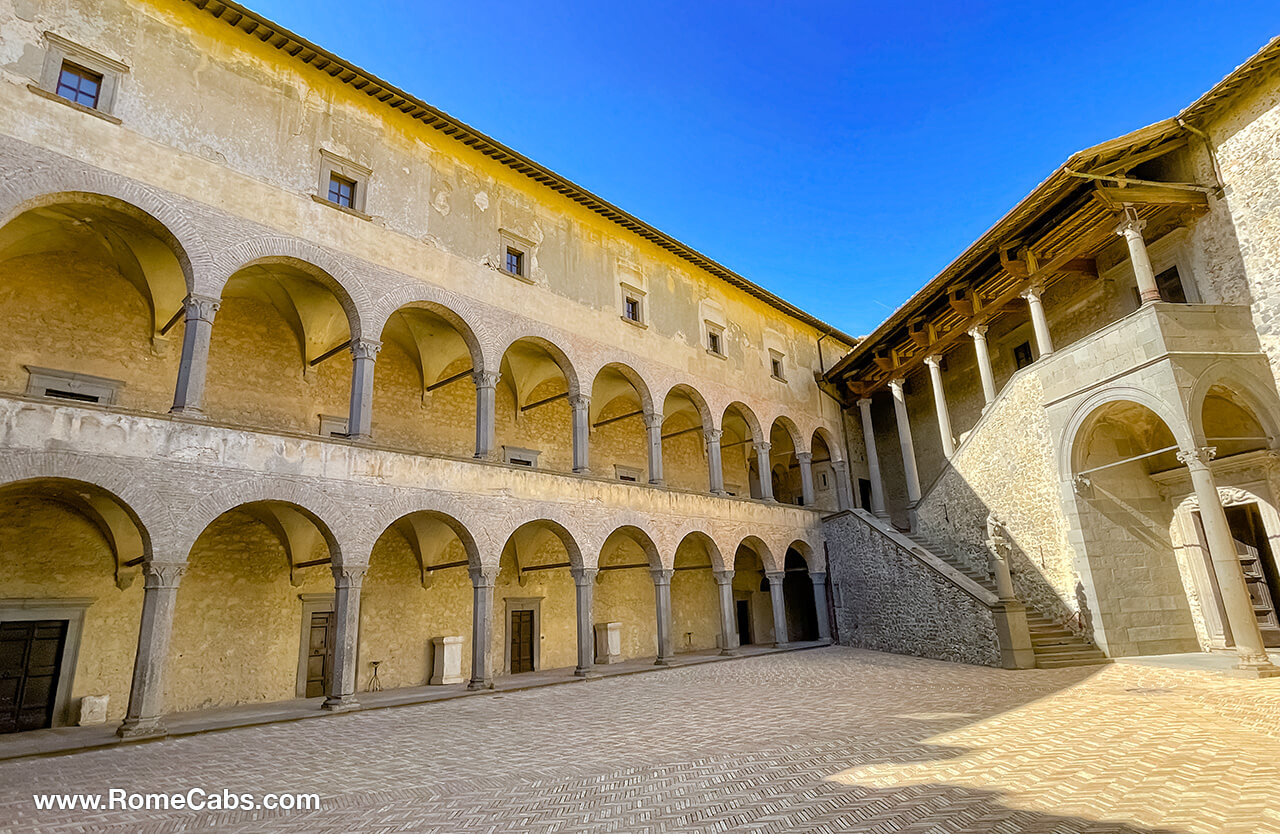
The official celebration of Paolo Giordano and Isabella's marriage took place near Florence in 1558, when the couple was still in their teenage years. These were pivotal years for the lord of the castle, when Paolo Giordano, not even 20 years old yet, witnessed the elevation of Bracciano to a duchy by Pope Pius IV, marking a significant milestone in his burgeoning career.
As you continue your exploration of Bracciano Castle, you'll delve deeper into the lives of Isabella de Medici and Paolo Giordano including enduring legends, startling scandals, and alleged murders that shrowd this famous Renaissance couple in palace intrigue.
The Ancient Castle Kitchen
On the left side of the square, you'll encounter the entrance to the ancient castle kitchen, featuring a well near the front door. Notably, this well is intricately connected to the immense cistern located adjacent to the armory.
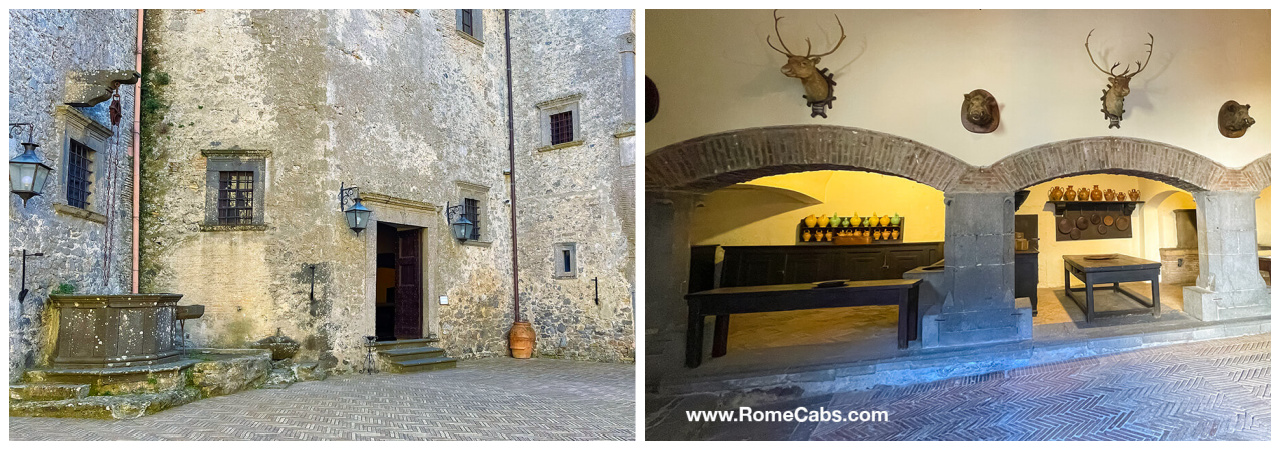
The placement of castle kitchens away from the main castle structure was a strategic choice during the medieval and Renaissance eras, designed to mitigate the risk of kitchen fires spreading to the primary areas of the castle. Within the expansive kitchen, tasks ranged from meat butchering and food preparation to serving meals to members of the lower family court.
In the bustling kitchen, head chefs and their assistants oversaw a team of kitchen helpers responsible for crafting meals in accordance with Renaissance dietary customs. These customs dictated specific days for meat consumption, distinct days for fish, and a high regard for Lent observance. Additionally, grand feasts during major holidays were common.
Kitchen staff included individuals in charge of managing supplies, meat slicers, sommeliers responsible for selecting wines, and skilled artists tasked with creating elaborate, edible sugar sculptures for banquets. Preparing a banquet for 30-40 guests, for instance, necessitated nearly 90 individuals. The presence of the castle brought employment opportunities to surrounding villages as locals found work within the castle.
Rocca dei Vico and Defensive Ramparts
Leaving the kitchen behind, reenter the Court of Honor and venture through the courtyard garden towards the castle wall. Pass through the ancient Rocca dei Vico archway, named after the rulers of this region north of Rome who predated the Orsini family's establishment of their power center in this location.
This part of the castle grounds, which may appear somewhat dilapidated, actually existed for nearly two centuries before Napoleone Orsini extended the castle. It serves as a tangible representation of a Medieval Castle within the larger context of a Renaissance Castle.
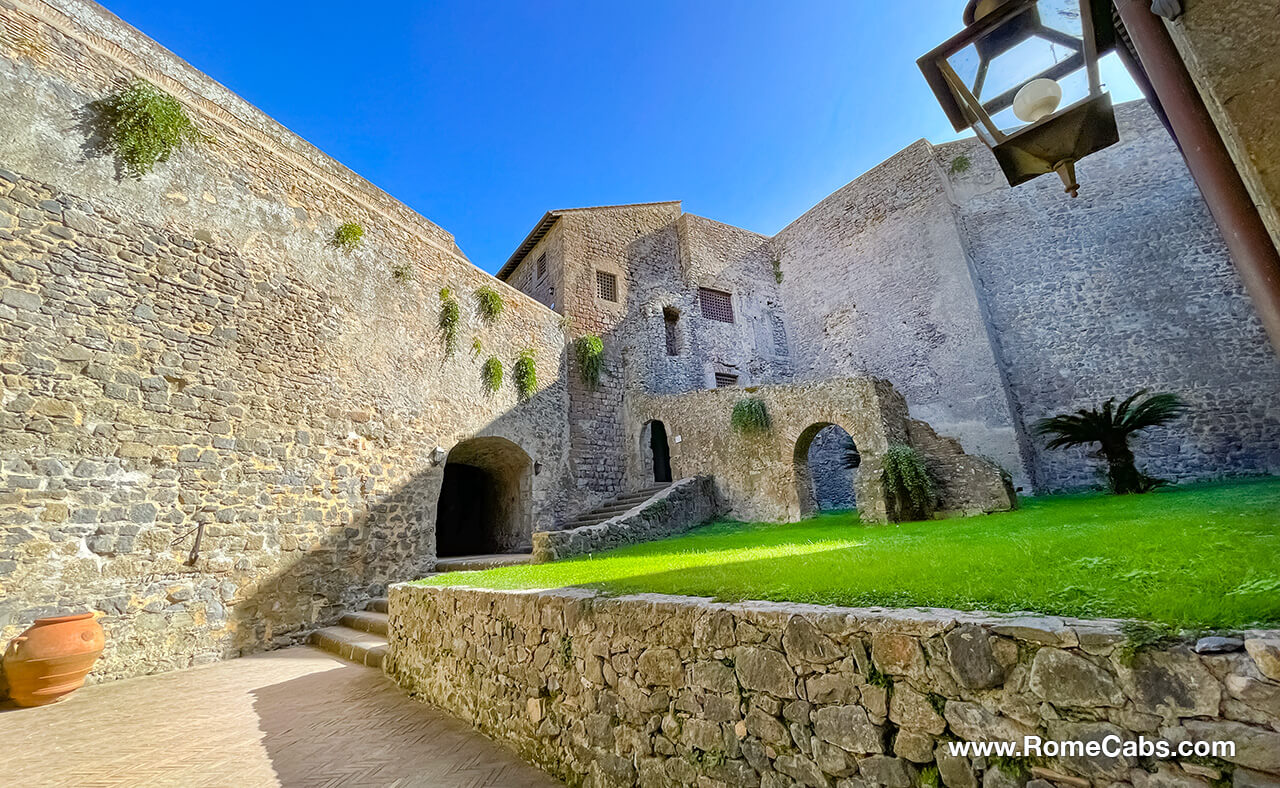
Panoramic Tower (Belvedere) - View of Bracciano Lake and Church of Santo Stefano
Continue your ascent up the stairs to reach the top of one of the towers, offering a breathtaking panoramic view from the castle’s ramparts.
The castle's rooftops are adorned with a multitude of chimneys, each room boasting its own fireplace, ensuring comfort and warmth during colder seasons.
From the elevated vantage point along the castle walls, you'll enjoy a magnificent view. Lake Bracciano sprawls in all its glory before you, and to your right, the Santo Stefano church stands with grace and poise.
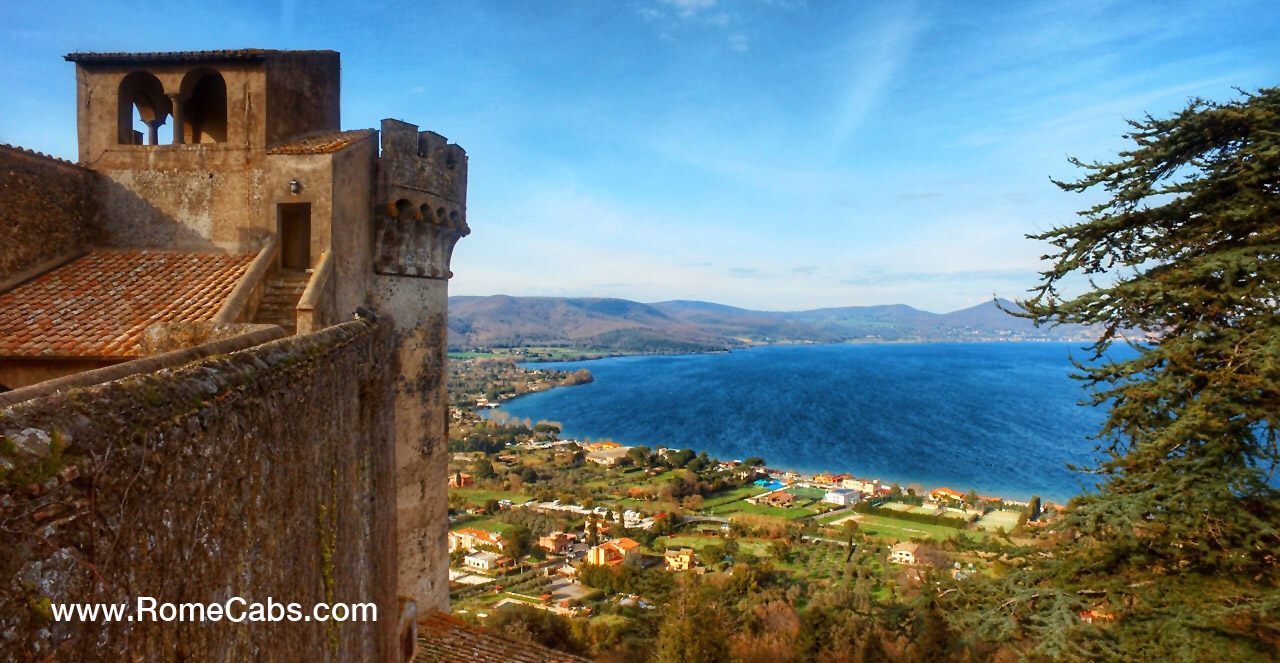
Walk along the Military Walkway toward Loggia with 2 arches
Step back and continue along the ramparts, which once functioned as a strategic military walkway leading to the loggia adorned with graceful arched windows. As you stroll along this narrow passage, take note of the small, strategically positioned windows within the walls that served as both observation points and countermeasures against enemies attempting to scale the fortress walls.
Imagine archers shooting arrows, defenders pouring boiling oil or water onto enemies below, or releasing projectiles like stones and crossbow bolts to thwart their advance. These openings were versatile features in castles’ defense, offering multiple methods to protect against potential threats.
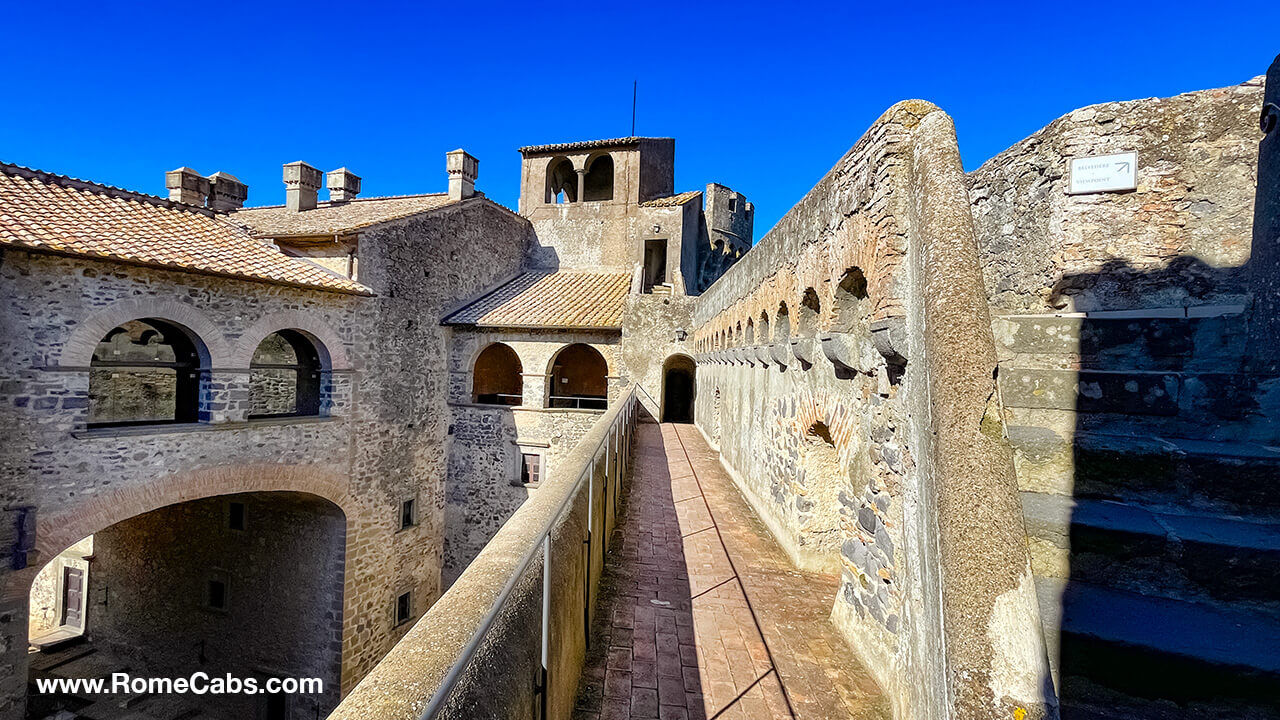
Explore the Upper Noble Floor of Bracciano Castle
Upon passing through the loggia with its two arches, you'll enter the upper noble floor, known as the "piano nobile" of the castle. Your visit begins inside the tower that looks towards the sunrise.
The Castle’s unique linear enfilade design
Before we begin with our tour through the noble rooms, we wish to bring to your attention one of the first things you will notice as you explore the castle: the linear enfilade design, a remarkable illustration of Renaissance architecture in which rooms are aligned in a straight line.
This design creates a structured and harmonious flow throughout the castle, where one room seamlessly leads into the next. Although lacking privacy, this layout emphasizes symmetry and elegance, holding both functional and symbolic significance during the Renaissance.
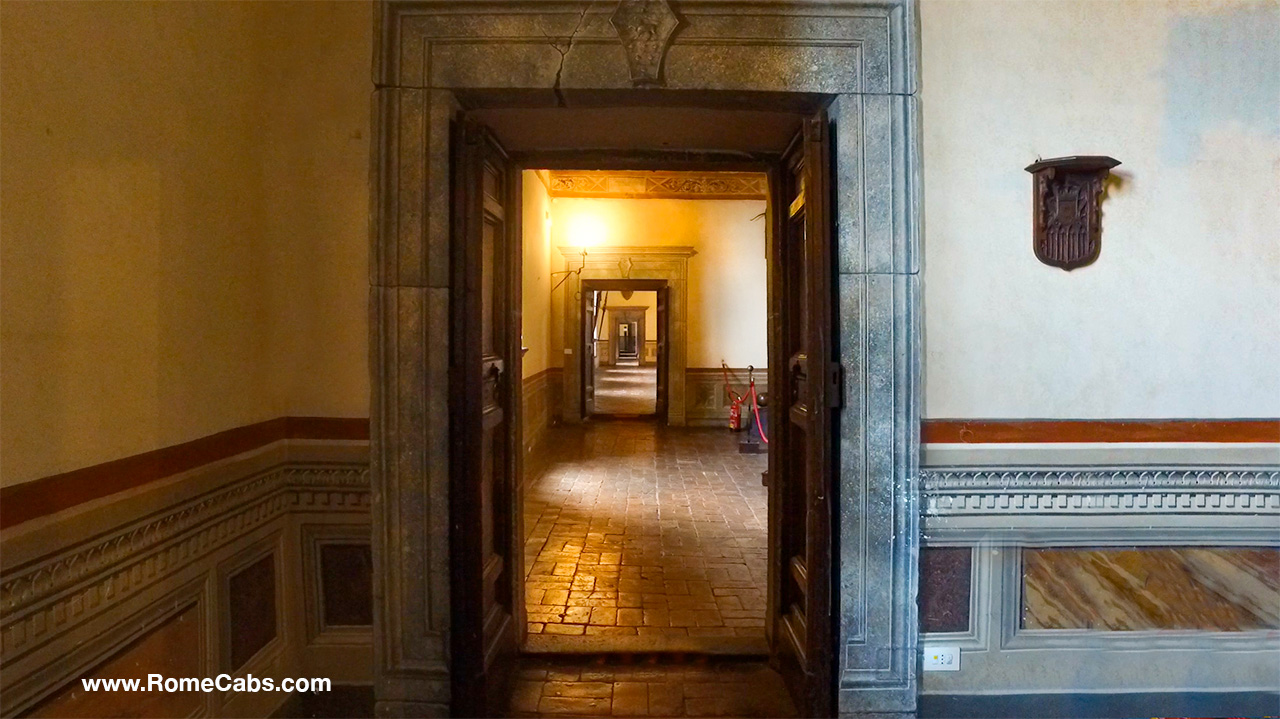
While the castle may exude an aura of solemnity and permanence from the outside, its interior rooms displayed a remarkable flexibility: namely the rooms could have changed their function between summer and winter, between male and female quarters, and reflect evolving lifestyles and statuses, or accommodate distinguished guests like Popes and Kings and their retinues.
Within these noble rooms, you'll observe generously sized windows, allowing an abundance of natural light to fill the spaces. These windows are adorned with Guelph crosses, representing the Orsini family's pro-papal politics.
Double-raised seats by the windows enable private conversations, contemplative moments while gazing out of the windows, and leisurely reading by the window for as long as daylight permits.
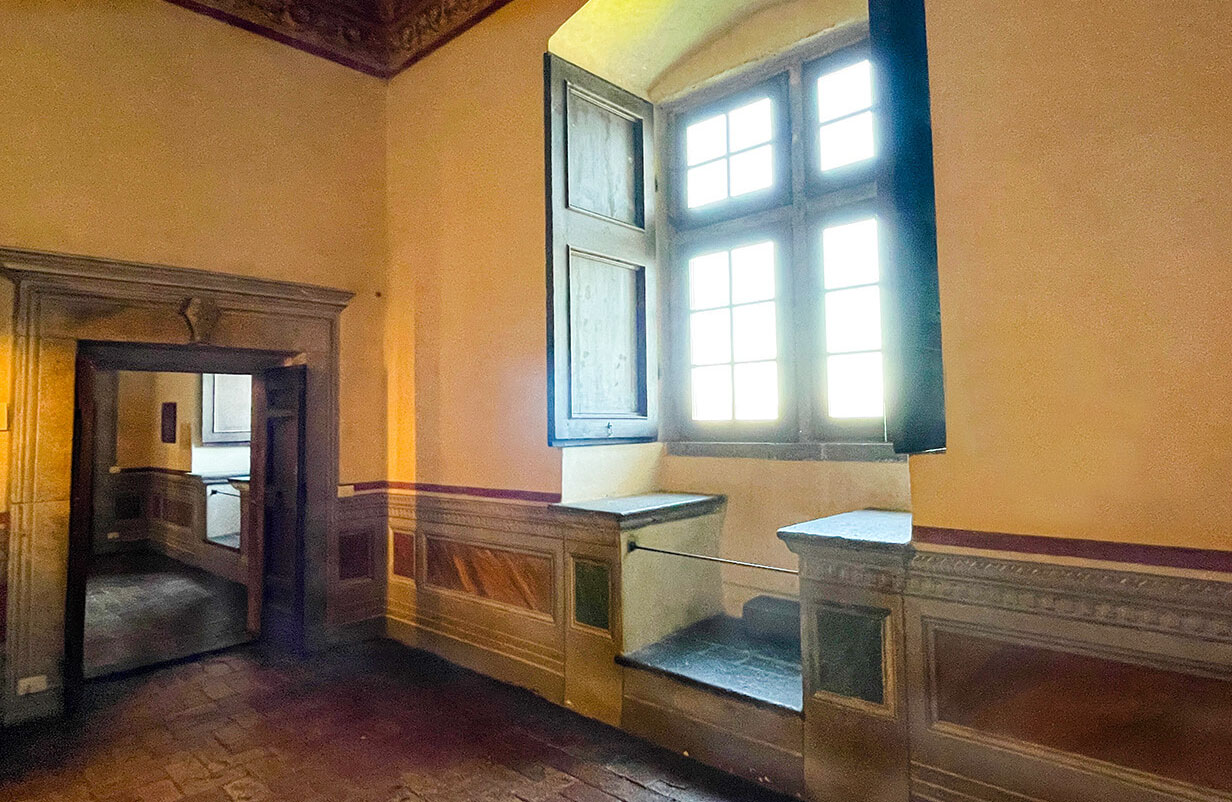
The noble rooms of Bracciano Castle exhibit lavish decoration on the ceilings and friezes, creating a striking contrast to the walls, which were typically covered with tapestries.
Tapestries added both color and texture, often featuring scenes, stories, or symbols of great aesthetic appeal. The quality and quantity of these tapestries served as a reflection of the castle owner's wealth and social status. Elaborate or intricately designed tapestries were a way to flaunt affluence.
Furthermore, tapestries offered versatility, as they could be easily moved or replaced, allowing for a change in a room's decor without requiring major renovations. Furthermore, tapestries provided an additional layer of insulation, helping to combat the drafty and cold nature of castles, trapping heat and making the space more comfortable. The Orsini family held such a high regard for tapestries that a tapestry factory was established in Bracciano.
Hall of the Coat of Arms (Sala degli Stemmi)
Upon passing through the loggia with its two arches, you'll enter the upper noble floor, known as the "piano nobile" of the castle. Your visit begins inside the tower that looks towards the sunrise.
In the first room, the Hall of the Coat of Arms, you will notice the heraldic Coat of Arms of the two main families of Bracciano: Orsini on the right side, and Odescalchi on the left side.
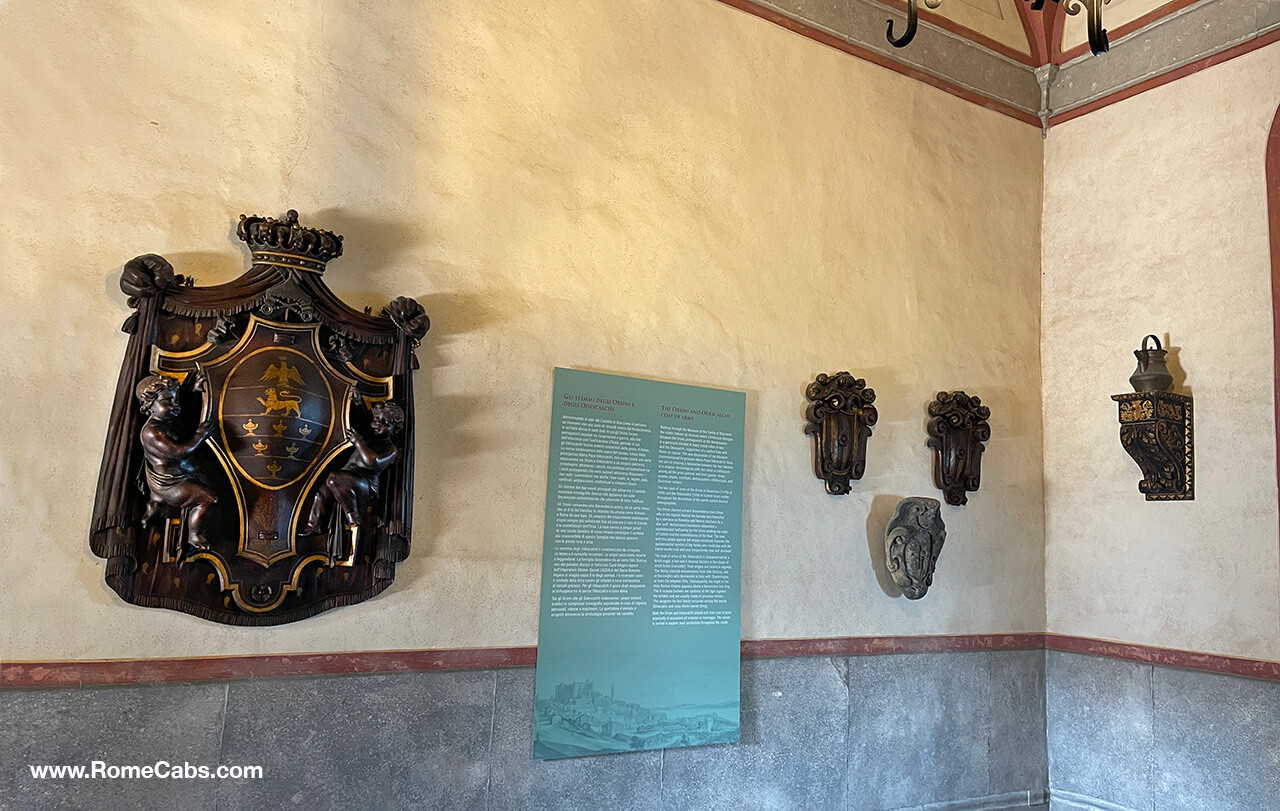
As you already noticed, the Orsini played with the symbols of the She-Bear (Orsa) and the Rose (Rosa).
The Odescalchi family, originally of Lombard origin, proudly incorporated an imperial eagle of the Holy Roman Empire, a benevolent regal lion, and 6 incense burners in the shape of small boats, religious symbols against infidels (non-Christians).
Just like the Orsini claim to be descendants of legendary Ursus who was breasted by a she-bear as Romulus and Remus were fed by a she-wolf, the Odescalchi claimed legendary descent from Charlemagne. The family name 'Odescalchi' is believed to have originated from 'Odo Scalcus', a Carolingian paladin who served as a knight or warrior under Charlemagne or Emperor Otto.
Symbols of both the Orsini and Odescalchi coat of arms are visible throughout the castle.
Proceed to the following room and observe the impressive sequence of interconnected rooms and antechambers arranged one after another in an enfilade sequence.
The Etruscan Hall (Sala Etrusca)
The Odescachi family used this room to exhibit their collection of antiquities, particularly Etruscan and Roman.
From here you can reach the Armor Loggia. You can see the doorway as it leads into a room adorned with armor.
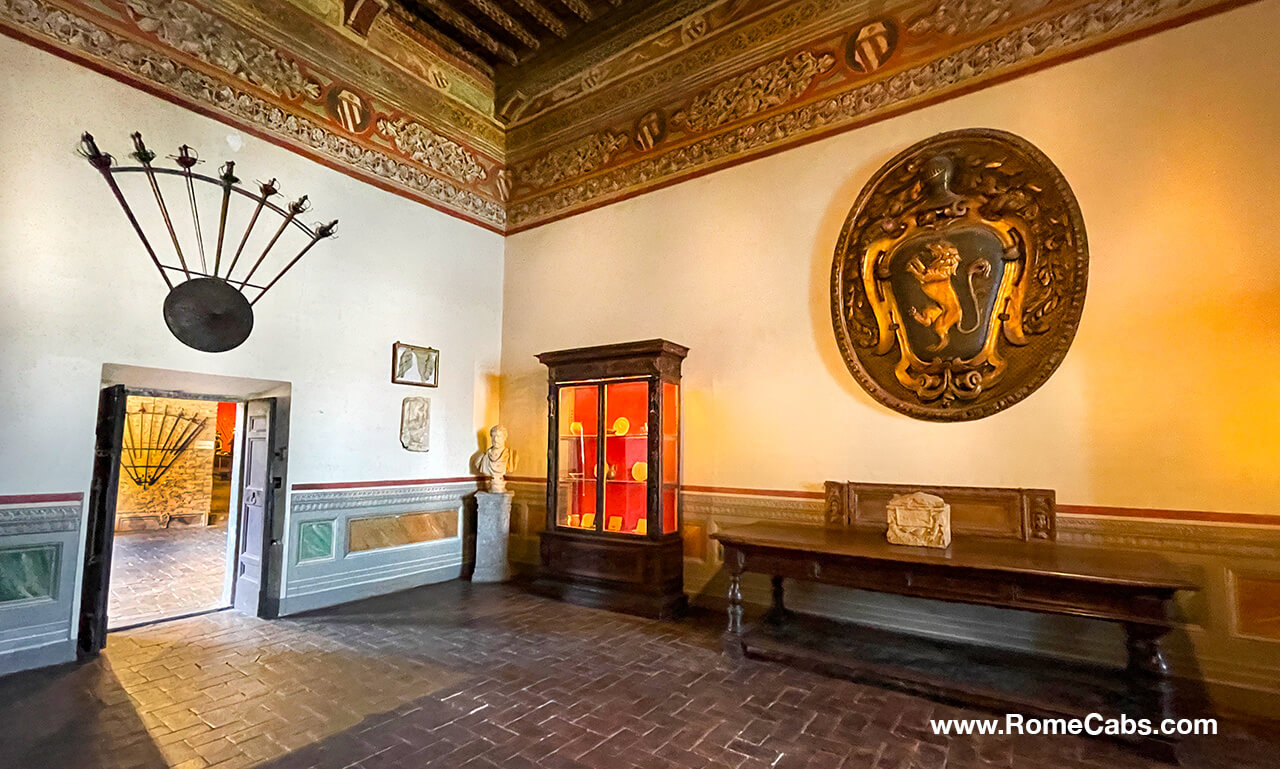
Loggia of the Armor (Loggia delle Armi)
This room features two full-body of Maximilian-style plate armor on display representing the most advanced technology of the time for the defense of the body in battle melee and the evolution of metallurgy that can withstand more dangerous firearms.
The Maximilian armor, named after Maximilian II, was crafted specifically for him, marking its resurgence after a lapse of seventeen years from common use.
This armor was intricately designed to mimic the fashionable pleated garments of that era in Europe. It featured elongated, pleat-like fluting patterns paired with rows of rectangular motifs that resembled contemporary textiles adorned with slashing and quilting.
Key characteristics of Maximilian armor encompassed the adoption of closed leather-lined helmets with breathing holes, breastplates, armets, tapered cuirasses, sabatons, knee protection, greaves, and the incorporation of closely arranged, parallel fluting patterns.
During the 15th and 16th centuries, there emerged a trend in Europe to create armor that not only offered the utmost protection but also exuded visual elegance. Maximilian armor skillfully blended the curved Italian style with the fluted German design, achieving a harmonious combination of form and function.
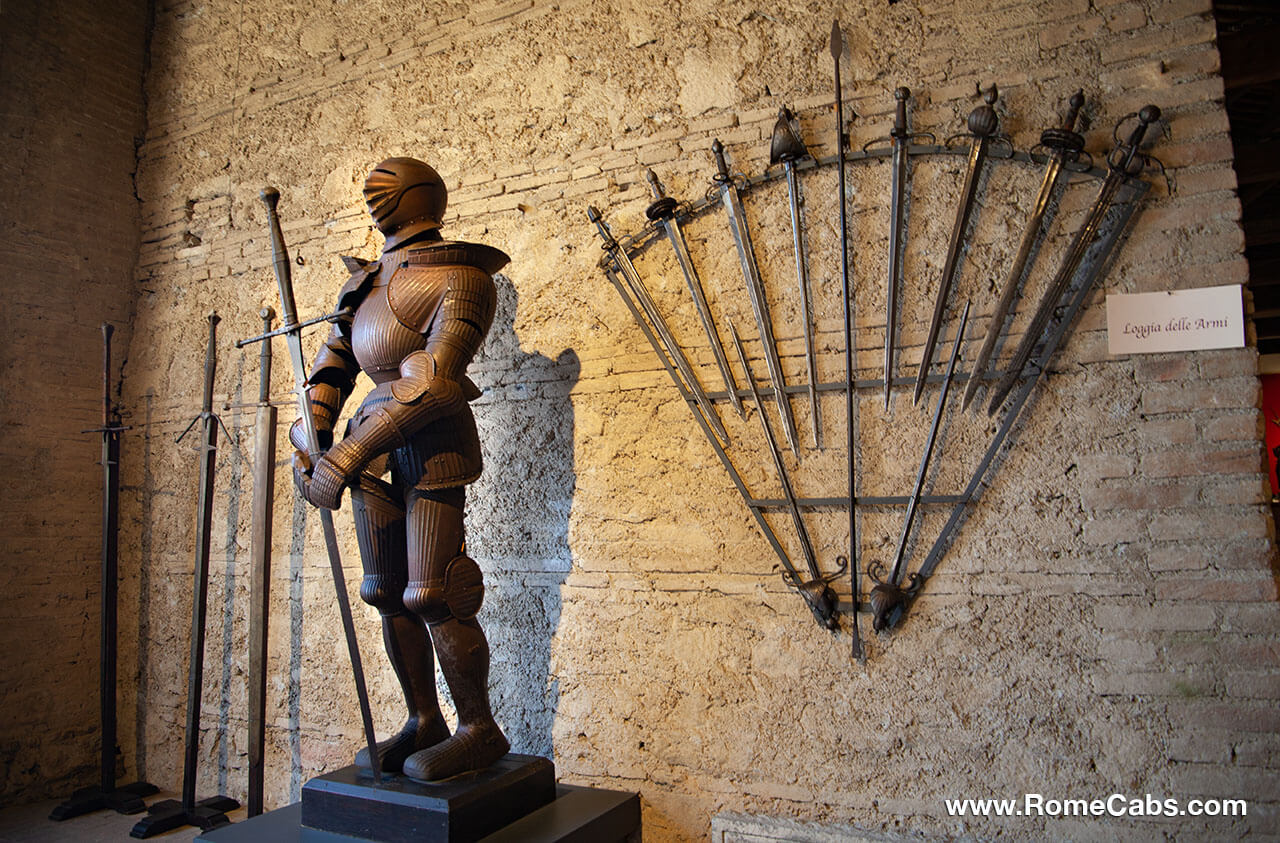
Hall of Gentil Virginio (Sala di Gentil Virginio)
This large room that once belonged to Gentil Virginio now hosts an array of Odescalchi’s armor on display, as well as a large painting mounted on the left wall commissioned by the Orsini family.
The Hall of Gentil Virginio and the Odescalchi Armors provide a captivating insight into the world of Renaissance-era "condottiere" and the weaponry that defined that period.
Odescalchi Armor (Armi Odescalchi)
The Armor collection of Renaissance-Era armor represents a small portion of the monumental armory collection assembled by Ladislao Odescalchi in the late 19th century. Here, you can admire complete 16th-century armor made in Germany and various sections of armor made in Italy. Here you will see an array of helmets from simple cabasset to zishagge in the form of a hat, and accessories like aventails and protective nets.
Weapons from the Middle Ages such as the corseques with winged cuspids and brandistocks that were used to break the armors of enemies, basket-hilted swords, and horse bridles with faceplates.
If for Gentil Virginio weapons were indispensable and used according to sophisticated military manuals, for Ladislao they were part of a precious collection to fashion himself according to a chivalric figure in a time dominated by a revival of Renaissance style.
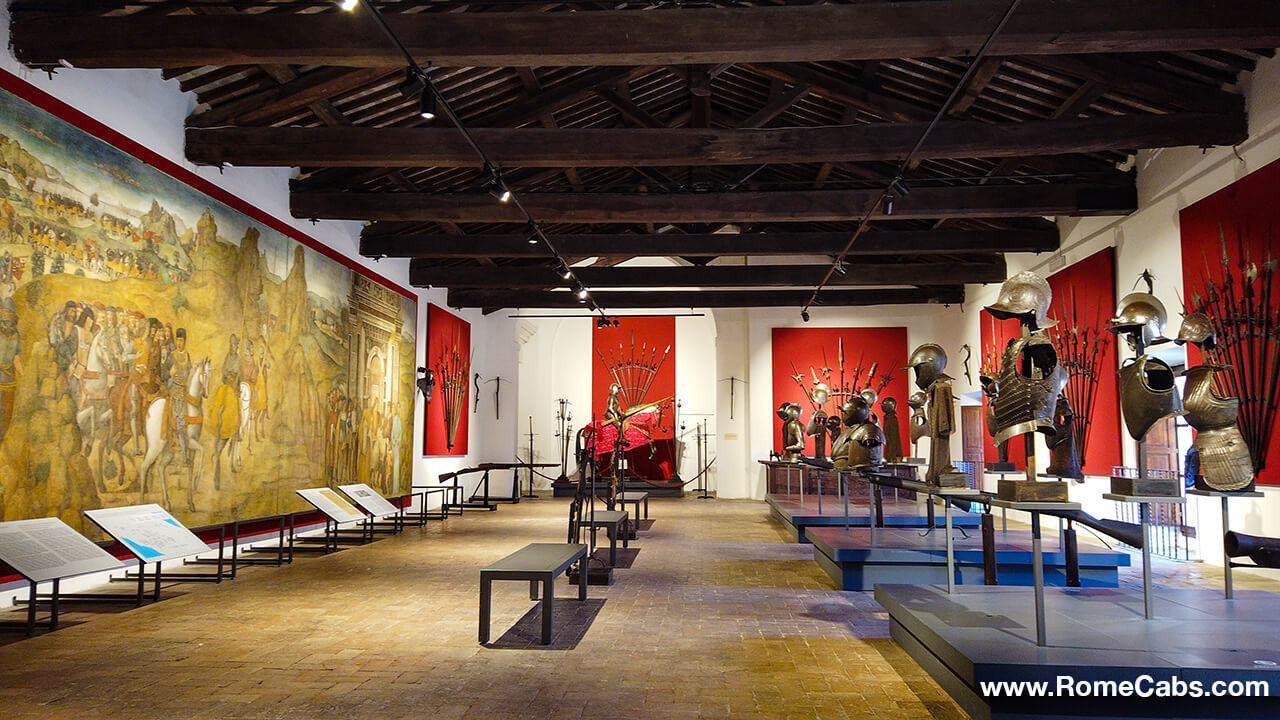
Condottiere - Italian mercenary captains
At the dawn of the 1500s, the transformation of weapons into sophisticated firearms revolutionized military strategies overshadowing the figure of “condottiere” who had become a legendary character between the Middle Ages and Renaissance and diminishing the traditional value and loyalty of the knight giving power to a military man lacking tactical ability.
A "condottiere" was a professional military leader or commander for hire during the Middle Ages and Renaissance in Italy. The term condottiere is derived from the Italian word "condotta", which means a contract or commission. These "contractor mercenaries" were contracted by city-states, noble families, or other entities to lead their armies in times of war.
Condottieri were known for their tactical skills, leadership abilities, and the effectiveness of their armies. They led bands of professional soldiers and were motivated by financial gain. They were paid through contracts that often included a base salary and additional rewards or bonuses based on their performance in battle.
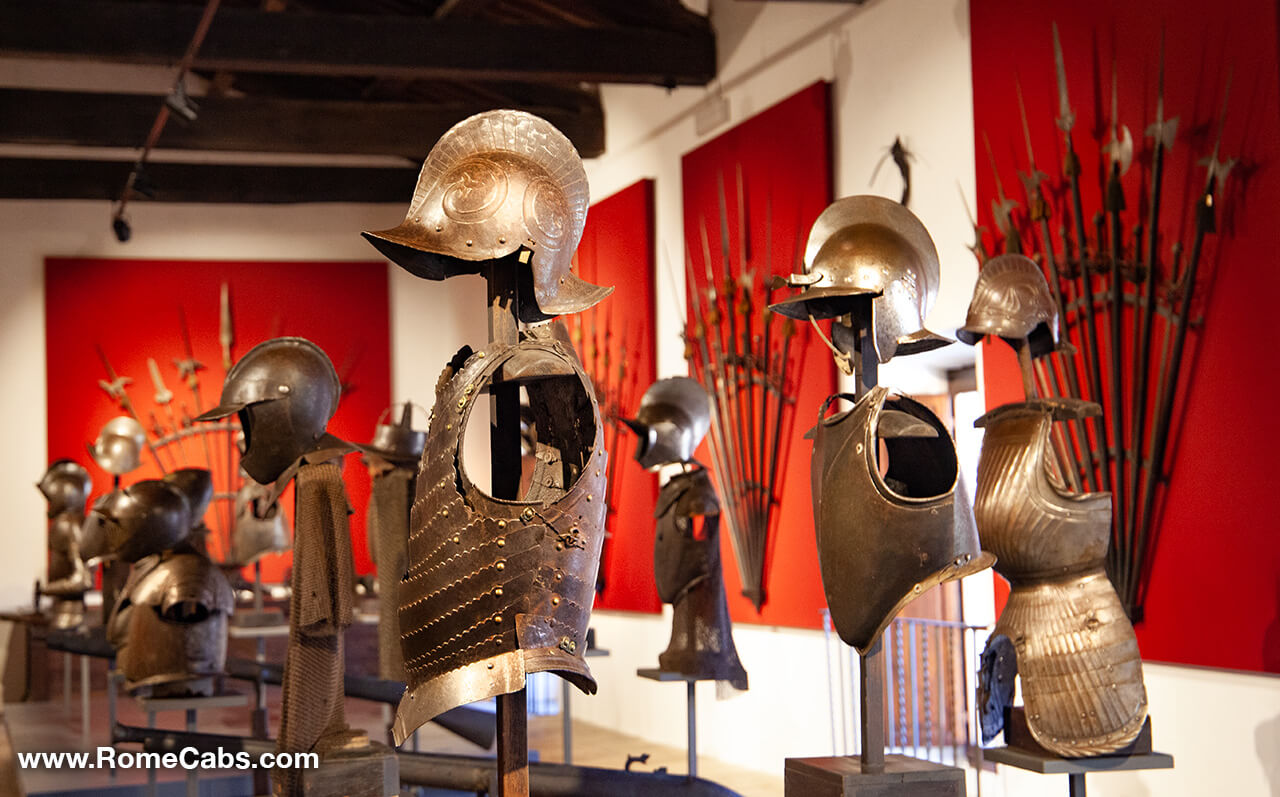
Gentil Virgino’s Cavalcade and Meeting with Piero de’ Medici Fresco
This grand 11-meter-long fresco by Antoniazzo Romano which was originally placed under the arch at the entrance of the castle’s courtyard depicts two important moments in the life of Gentil Virginio Orsini that occurred at the end of the 1480s.
On the left side, you'll see a triumphal cavalcade or grand triumphal procession that took place on October 28, 1489. In this vivid scene, military squadrons, donned with helmets and mounted on horses, make their way forward from the background. They follow winding paths across the terrain surrounding Lake Bracciano, which includes marshlands, hills, and gorges.
This scene celebrates the nomination of Gentil Virginio as captain of the Aragonese army received directly by King Ferdinand of Naples. The military parade symbolizes his leadership, with Gentil Virginio prominently positioned in the foreground on a white horse, flanked by three soldiers carrying gilded spears.
Gentil Virginio wears the signature Neapolitan hat, the collar of the Order of the Ermine, and wields the baton of command for the Aragonese troops. The landscape is adorned with fortresses, notably the Castle of Bracciano, which is depicted under construction.
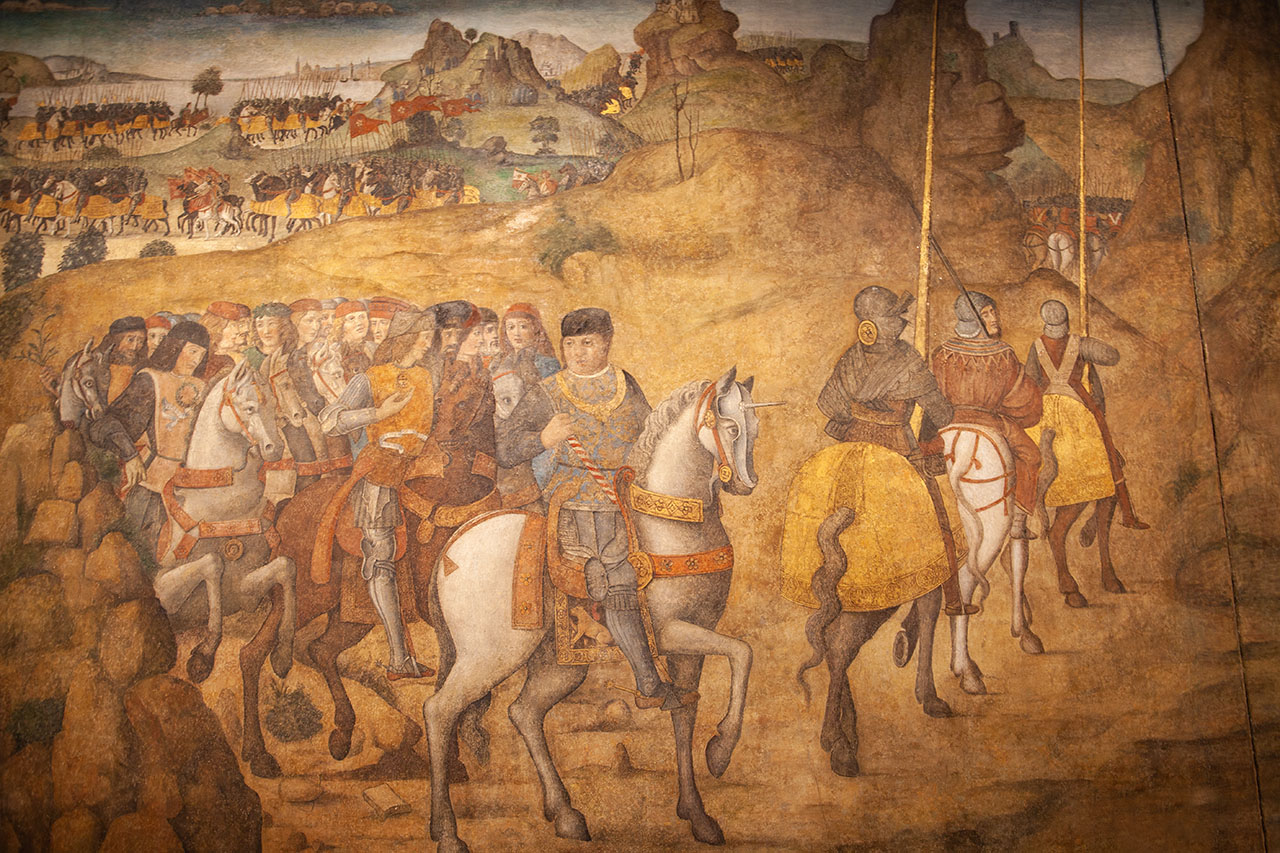
On the right side, the painting depicts Gentil Virginio meeting his 16-year-old nephew Piero de’ Medici in 1487 who stopped in Bracciano during his travel to Rome for the wedding of his sister Maddalena with Franceschetto Cybo. The scene, set under an elegant arch, showcases young Piero de Medici genuflecting before the Lord of Bracciano, signifying the Orsini-Medici connection.
Gentil Virginio, positioned to the right in his purple cloak, is accompanied by an ecclesiastic, potentially Cardinal Giovanni Battista Orsini, and his son Gian Giordano, who wears a pale blue garment and appears to be glancing to his left.
The Medici court exudes opulence with its stylish attire, vibrant hats, and precious feathers, symbolizing affluence and extravagance. Within the group, there is also a Moorish page, the "moço d'espuela" from the Aragonese court, characterized by bichromatic stockings and a mantle with elaborate sleeves.
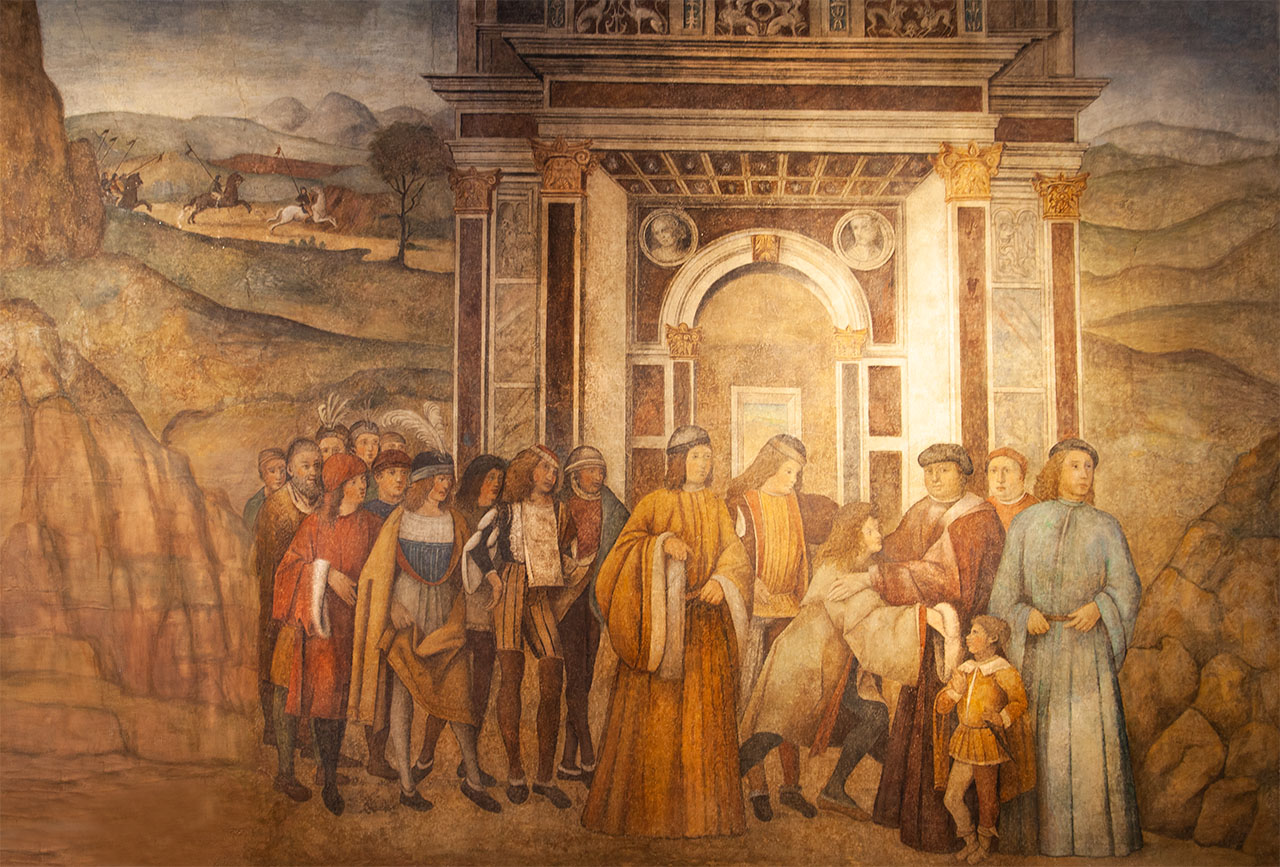
Hall of the Canopy Bed (Sala del Baldacchino)
While renovated in the 19th century by the Odescalchi family, the Hall of the Canopy Bed still reflects the living space as it was during the reign of the Orsini duchy.
Bedchambers like this one provide a glimpse into the nighttime routines of the castle's inhabitants.
During the Renaissance, less affluent families often shared a single room, resting on straw pallets placed on the floor. Given that many households used braziers to warm their chambers, there was a constant risk of straw causing a fire. In the homes of the nobility, bed chambers were more private, featuring a fireplace to safely heat the space.
In the 15th century, these rooms were also used for social gatherings where the lord would meet with ambassadors and nobles. By the 16th century, bed chambers had evolved into more private spaces, primarily used for sleeping or conceiving children.
Four-poster beds, like the one in this room, featured curtains that not only offered privacy but also protected the sleepers from light, cold drafts, or insects. Mattresses were typically filled with materials like wool, horsehair, or feathers, and then covered with silk.
Various-sized pillows served as makeshift recliners, enabling sleepers to rest in a nearly upright position, as it was believed to aid digestion. Since physicians of the time thought that sleep contributed to digestion, men and women often retreated to their beds after meals.
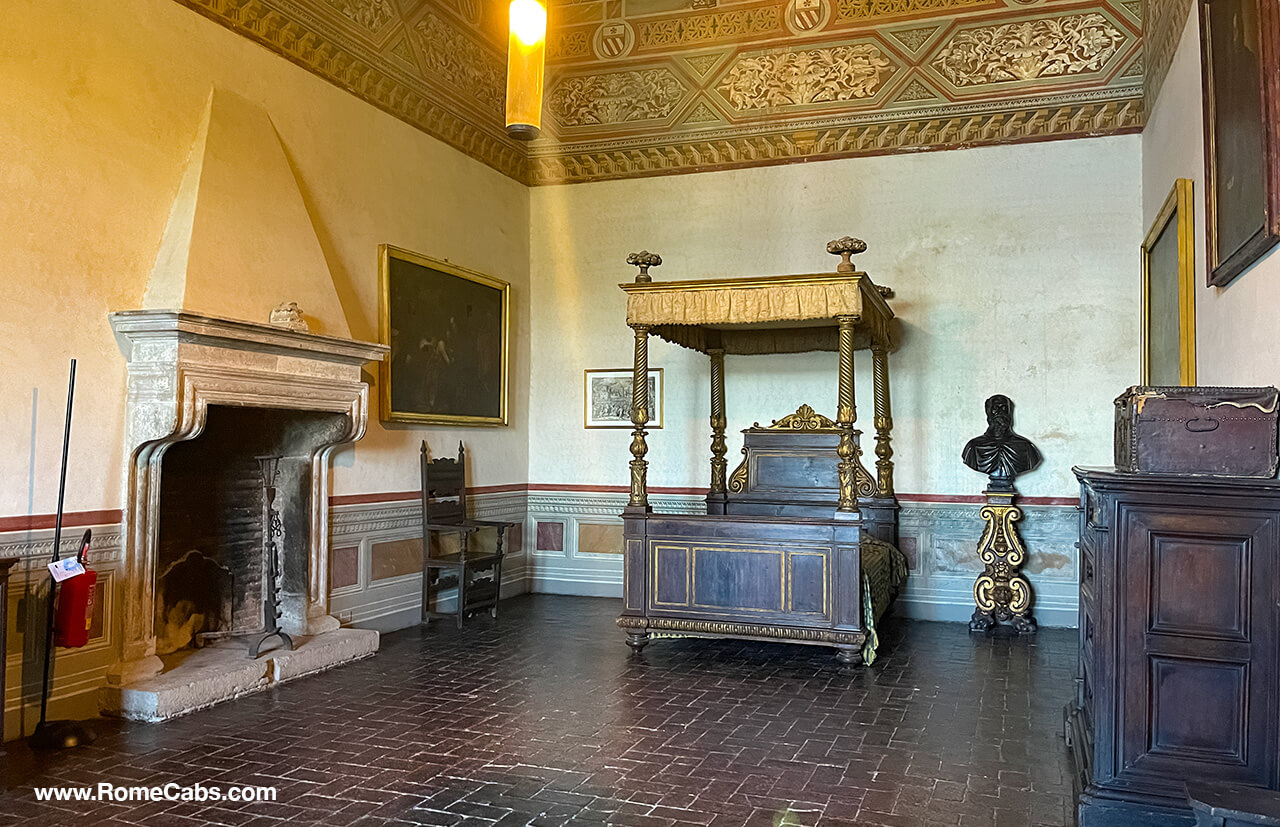
Beds also held a special significance in the cycle of life, representing places where people were conceived, born, and passed away. This connection often led individuals to have a strong attachment to their beds, to the extent that some, like Paolo Giordano, even traveled with their own beds.
In centuries past, continuous sleep for 7-9 hours was not the norm. Sleep was frequently divided into two segments, with individuals waking in the middle of the night for prayers. These nighttime prayers offered a sense of comfort and protection for both the body and the soul.
Bedchambers were typically divided into separate wings for males and females, largely because women were frequently pregnant, and their rooms served as pre and post-partum sanctuaries.
Indeed, the interconnected sequence of rooms offered limited privacy, but the sight of nudity was less scandalous since lords had attendants to assist with dressing and bathing in a tub placed within the bed chamber. It was commonplace to see wet nurses nursing noble infants.
Hall of Science (Sala delle Scienze)
This room, the Hall of Science, possibly served as a library. The frieze of paintings here features various disciplines, including music and astrology, depicted as allegorical representations inspired by Medieval tarot cards.
Today, this room houses a collection of 15th-century Marion icons from the Odescalchi collection. During the Renaissance, it was customary to keep an icon in the bedroom as a source of solace during times of war, natural disasters, illness, or maternity.
Flanking the window are two panels with 16th-century paintings of the Annunciation, which originally served as organ doors. In the left panel, Archangel Gabriel presents the virginal lily to Mary while conveying the greeting, "Ave Maria gratia plena" ("Hail Mary, full of grace"). In the other panel, Mary is depicted in her bedroom, surrounded by books and inscriptions symbolizing the divine word turning into flesh.
In the center of the room stands a late medieval Pieta, a theme that first emerged in Germany and later in Italy, culminating in Michelangelo's renowned Pieta, currently on display in Saint Peter's Basilica in Vatican City.
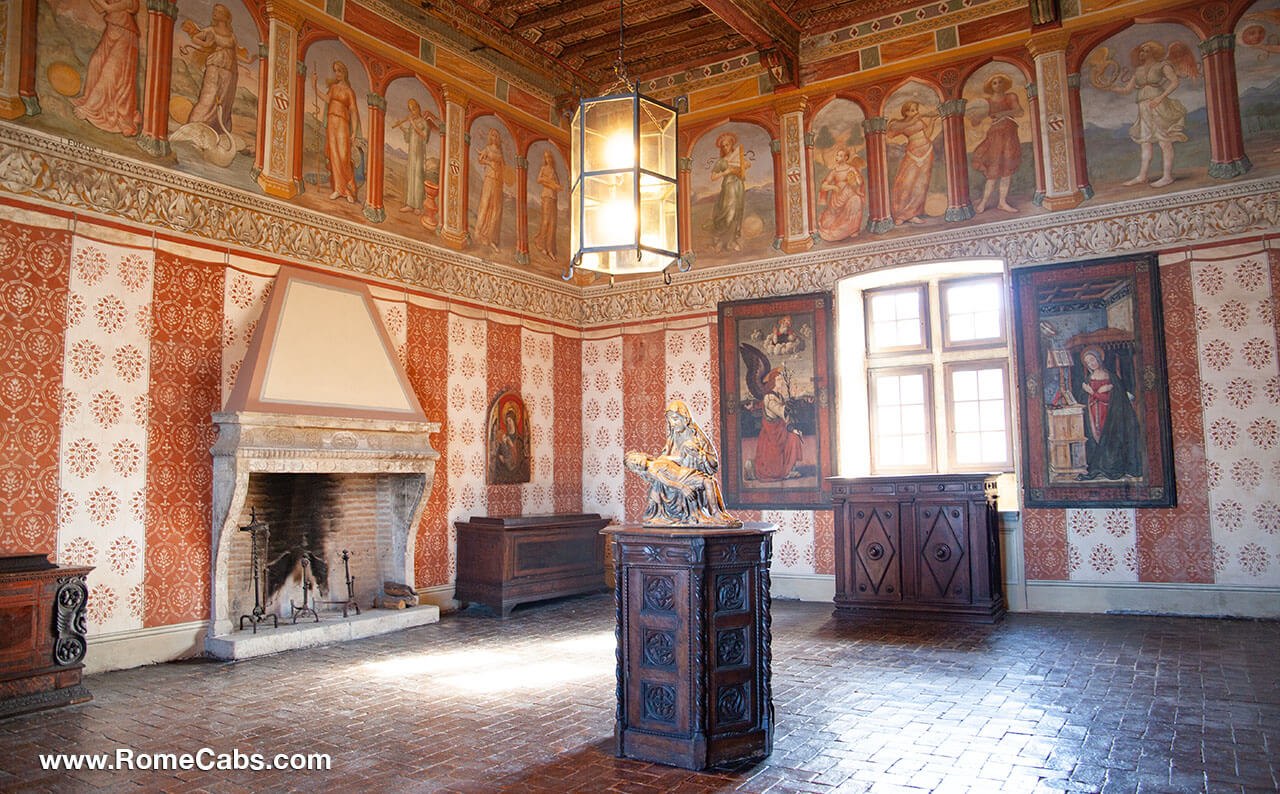
Hall of Felice della Rovere (Sala Felice della Rovere)
The Hall of Felice della Rovere is dedicated to Felice della Rovere, who was the grandmother of Paolo Orsini. You can find her portrait in the corner of the room near the fireplace. Felice was the illegitimate daughter of Cardinal Giuliano della Rovere, who later became Pope Julius II when Felice was about 20 years old.
At the bequest of her father, she was married to Gian Giordano Orsini, the heir of Bracciano. Felice was an educated, astute, and courageous woman who had the opportunity to meet renowned artists like Leonardo da Vinci, Raphael, and Michelangelo while they were working on the Sistine Chapel ceiling under the commission of Pope Julius II.
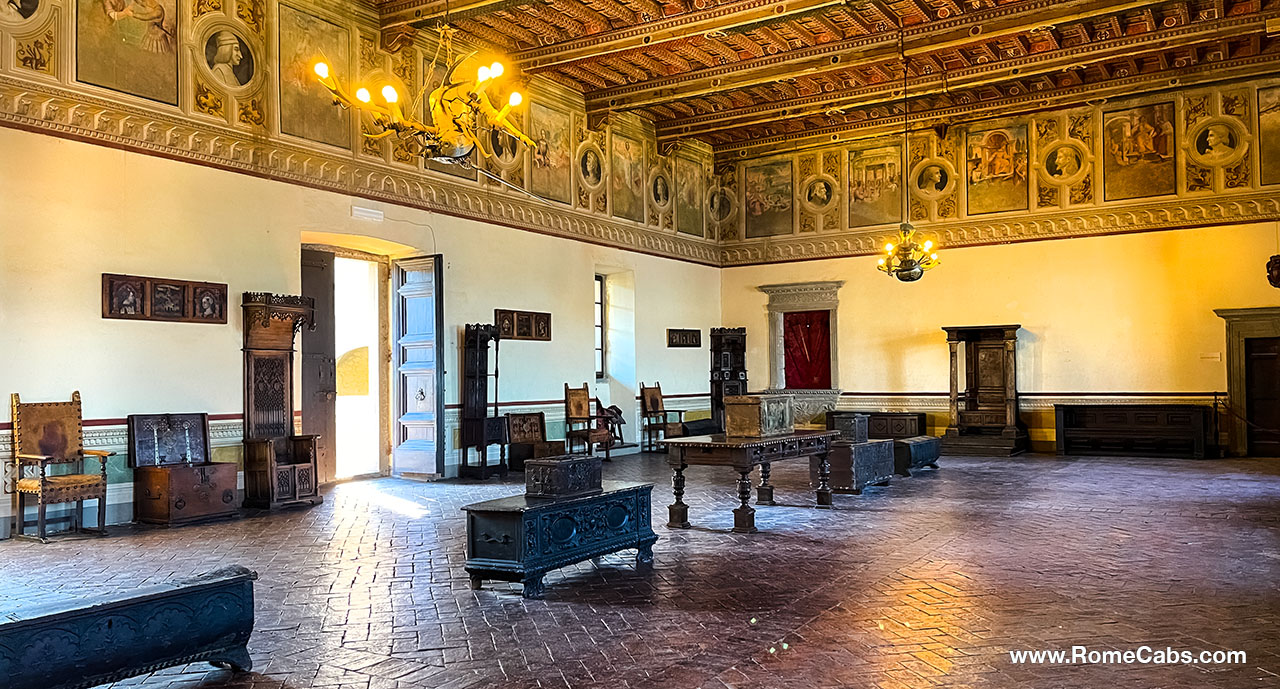
Following her father's death, she retained her influence within the Vatican, maintaining relationships with cardinals who later became popes.
After her husband's passing, the widowed Felice assumed the role of governor (gubernatrix) of the Orsini lands, which encompassed the castles, roads, agriculture, jurisprudence, state affairs, and family matters. She passed away at the age of 53, secure in the knowledge that she had secured the castle's legacy for her son, who would later become the father of Paolo Giordano.
The frieze adorning the upper portions of the room just below the ceiling was painted by Antonio di Viterbo in the early 1500s. It includes monochromatic medallion portraits and a series of narrative scenes depicting famous women from ancient history, such as Lucretia, the Sibyls, Egeria, Clelia, and more. Among these heroines, one notable figure is Tanaquil, the Etruscan wife of Tarquinius Priscus, the legendary 5th King of Rome, who managed to transfer power to her descendants after her husband's death.
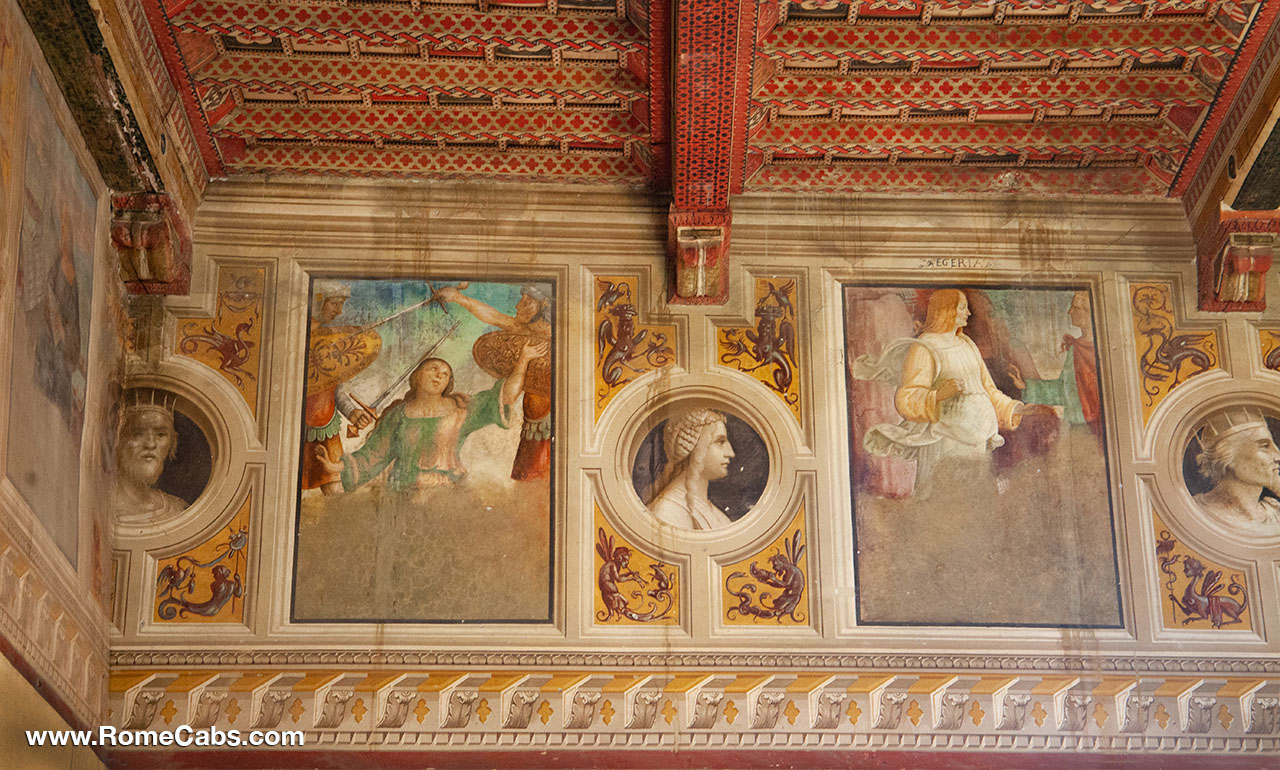
The walls of the room feature a series of ceiling coffers or tiles known as "Tavelle", with portraits of young ladies and knights. These were painted in Bonifacio Bembo's Lombard workshop around the 1460s.
Additionally, you can observe wedding chests in this room. These chests were traditionally used to carry bridal trousseaus and became metaphors for dowries, representing complex economic transactions between families to secure high-ranking husbands for their daughters.
Hall of Hercules (Sala d’Ercole)
The Hall of Hercules is aptly named after the upper wall paintings, which vividly portray 18 scenes depicting the Labors of Hercules.
Each scene is accompanied by Latin inscriptions that provide explanations for the various episodes. In homage to the demigod's legendary strength, the Odescalchi family chose this room to showcase a portion of their impressive weapon collection.
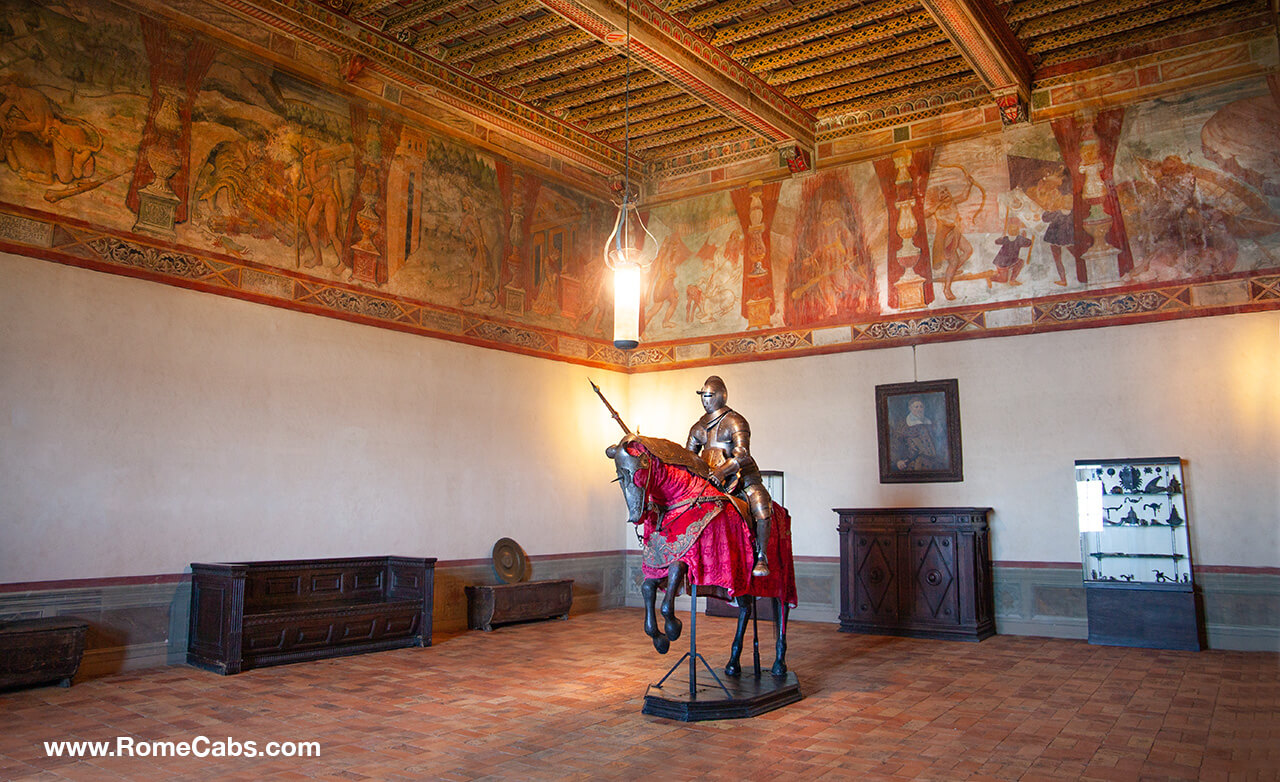
Gothic Hall (Sala Gotica)
The neogothic furniture in this Gothic Hall, which belonged to the Odescalchi family, reflects the 19th-century penchant for historical revival styles, influenced by the eclectic tastes of that era.
One notable piece of furniture in the Gothic Hall is a chair with a hidden commode concealed beneath the seat, essentially a toilet throne. In Italian, it was referred to as "lacommoda", which translates to "the comfortable chair" or a commode.
On the opposite wall, you'll find an ancient hourglass that precisely measured time for 8 hours, offering a unique method of timekeeping. Alternatively, the people of Bracciano relied on the tolling church bells of the Church of Santo Stefano or the church of Santa Maria Novella to keep track of time.
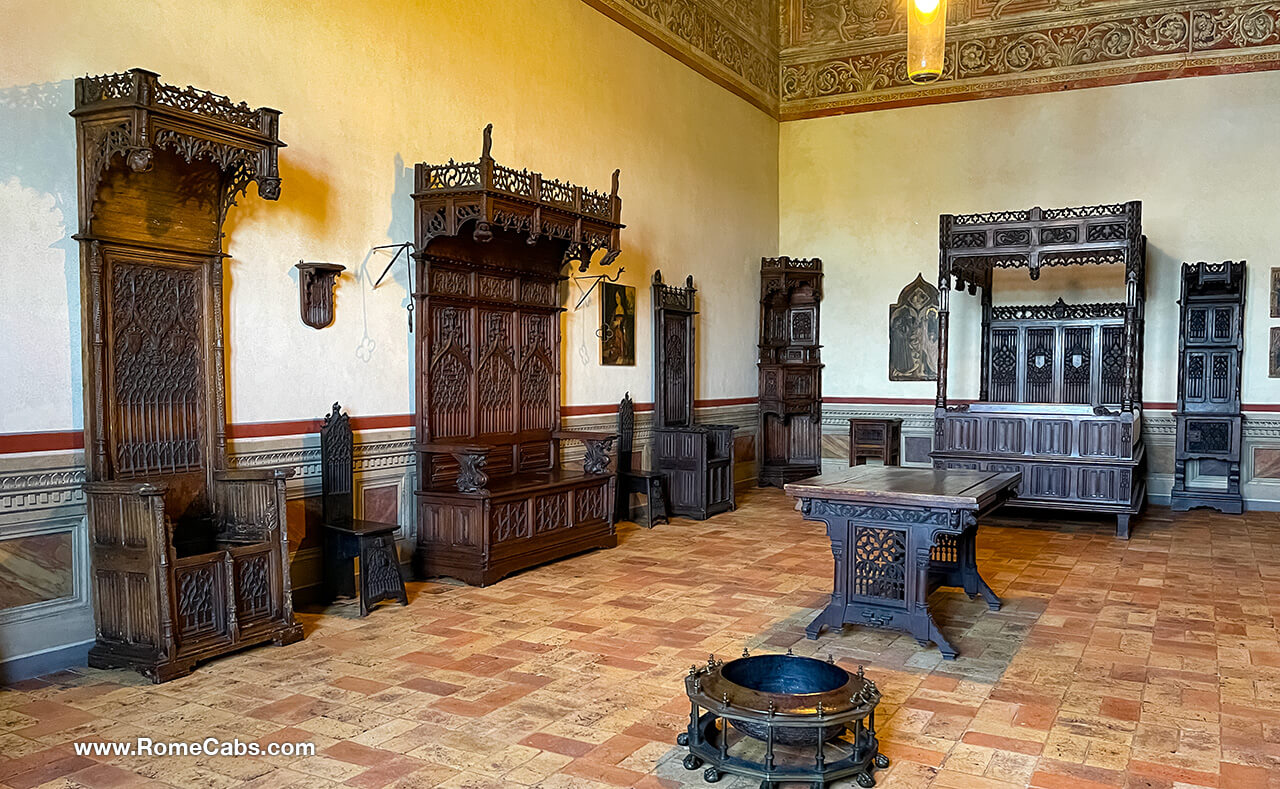
Hall of the Sicilian Bed (Sala del Letto Siciliano)
Hall of the Sicilian Bed is the last enfilade room of the upper noble floor in the tour that faces the sunset. This room is named after the Sicilian four-post wrought iron bed from the 18th century.
From here, proceed through the next door and climb down the spiral staircase (Scala a Chiocciola) to the Lower Noble Floor.
** Note that the spiral staircase may not be suitable for guests with mobility issues.
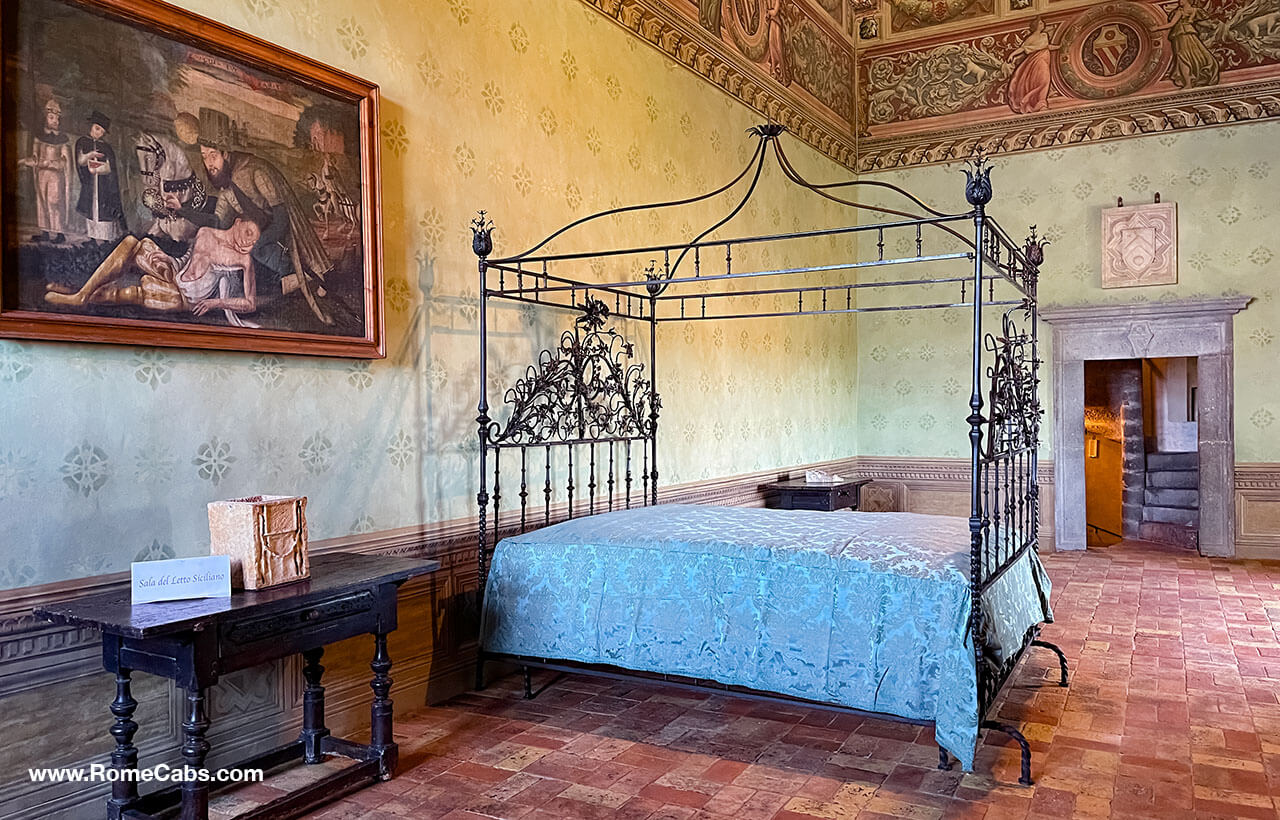
Hall of the Orsini Frieze (Sala del Fregio Orsini)
The Hall of the Orsini Frieze (previously known as the Isabella Room), is considered one of the castle's most exquisite rooms, featuring original furnishings. Its coffered ceiling is beautifully adorned with roses and family monograms, and the room boasts an ornate frieze that runs around the perimeter, showcasing the heraldic coat of arms of the Orsini family from Bracciano.
Historically, this room was believed to belong to Isabella de Medici, although it remains uncertain whether it served as her actual bedroom. Isabella, in fact, resided in Florence, where she looked after the family's affairs after the death of her mother. Her father, Cosimo de Medici, was reluctant to allow her to live in Bracciano or any of the palaces in Rome due to the presence of anti-Medici dissidents in the city, making it too perilous for his daughter to reside anywhere other than Florence.
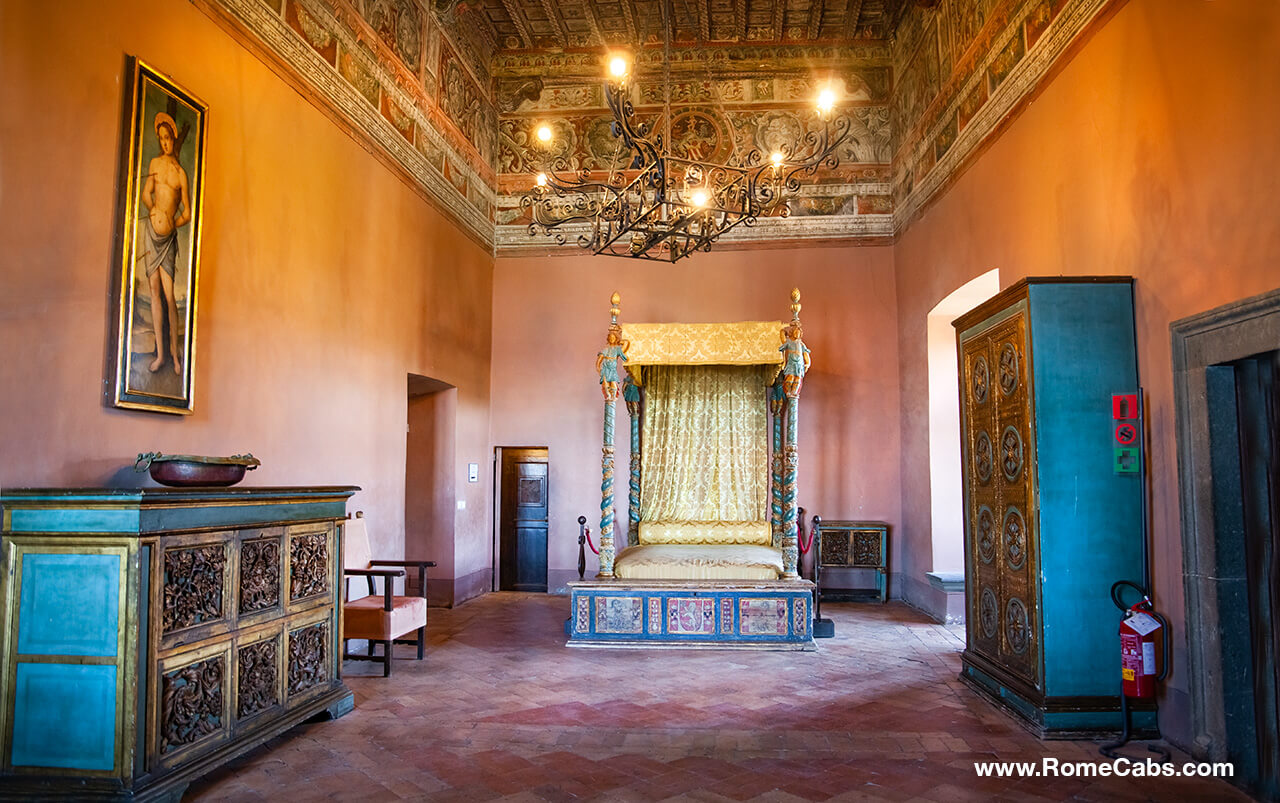
However, legends have spun a scandalous tale about this room, one that endured for centuries. The tale suggests that Isabella engaged in romantic affairs in this very chamber and, in a macabre twist, eliminated her lovers using a cleverly concealed trapdoor nearby, throwing her lovers into a well-equipped with blades and lime.
The story takes a darker turn as it's rumored that her husband, upon discovering her alleged infidelity, put an end to her life by strangling her with a ribbon. Isabella's death in 1576 at the age of 34 remained enshrouded in mystery and rumors, with questions lingering about whether it was caused by illness or murder.
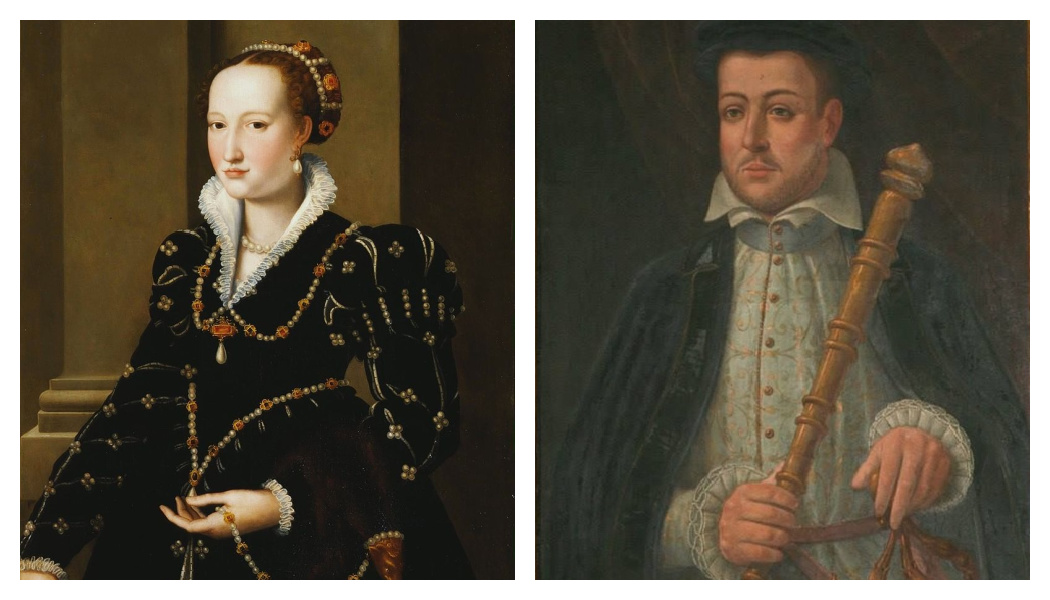
Within this web of legends, one historical fact was revealed that discredited claims of extramarital affairs and murder. A trove of over seven hundred letters exchanged between Isabella and Paolo Giordano emerges, shedding light on a robust and affectionate marriage that casts doubt on allegations of infidelity and murder.
In one of the discovered letters, Paolo wrote to Isabella:
“I adore you, beautiful, and believe that when I die, neither children, nor the State, nor friends, nor ladies, nor anything else will I remember, except that I adore you".
“I’ve only you. You, who I loved since childhood”.
Isabella's damaged reputation may have been exploited for political gain by opponents of the de Medici family. These adversaries, driven by malicious intentions and the diplomatic schemes of rival powers, aimed to tarnish her legacy. Over time, this negative portrayal was further perpetuated by novelists and playwrights.
- READ MORE about the intriguing saga of Isabella de Medici and Paolo Giordano on our travel blog: Isabella de Medici and Paolo Giordano Orsini - love, betrayal, murder, legends
Hall of Diplomacy (Sala della Diplomazia)
The Hall of Diplomacy showcases four paintings of Nicola Orsini III, the Count of Pitigliano, a renowned military leader from the 15th century. It serves as a tribute to the various branches of the Orsini family that extended their influence across Europe.
The Orsini family considered one of the most prestigious in Europe, produced leaders, cardinals, popes, and saints. While they formed alliances with influential families through marriage, the Orsini family also made enemies in Rome.
These adversaries included the anti-Medici faction, which posed a threat to Paolo Giordano's wife, Isabella, and Paolo Giordano's uncle, Cardinal Alessandro Farnese, who had acquired a fiefdom within the duchy of Bracciano.
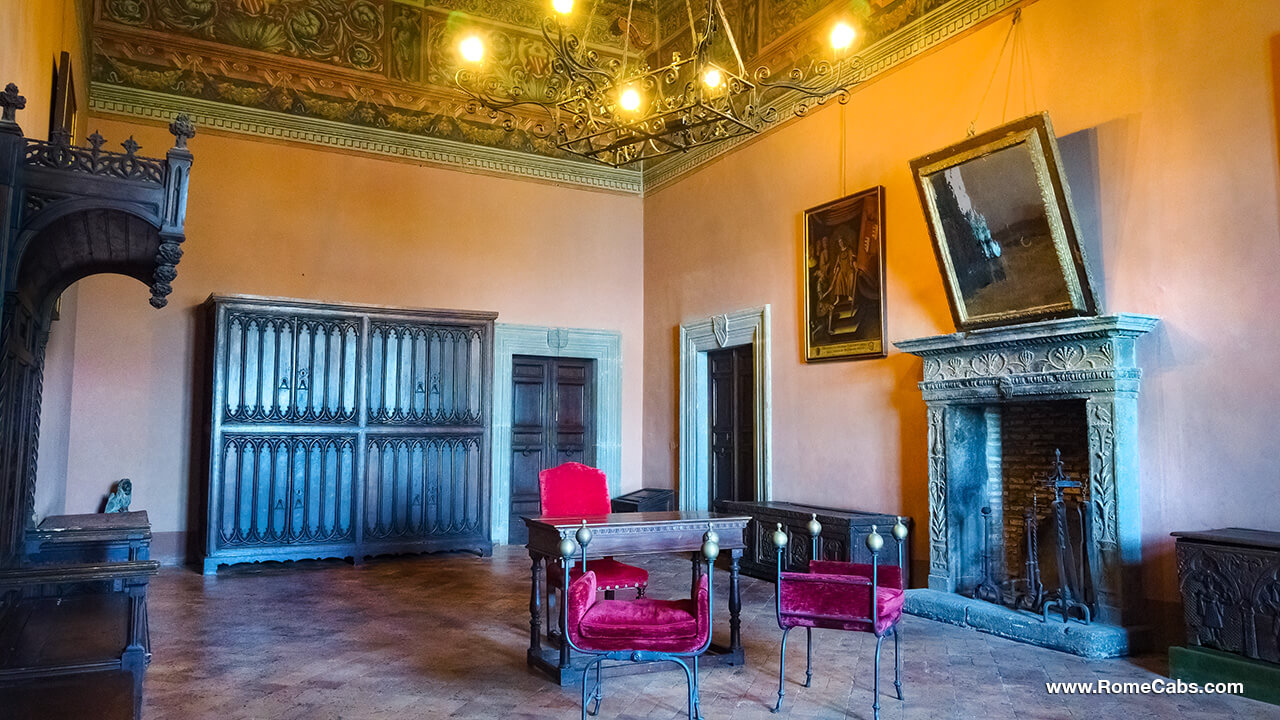
Orsini - Medici Hall (Sala Orsini Medici)
This Orsini Medici Hall features the coat of arms of the Orsini and Medici families and portraits of the most important characters of the Orsini and Medici families: Francesca Sforza di Santa Fiore, mother of Paolo Giordano, Cosimo de Medici Duke of Florence, Paolo Giordano Orsini at the age of 30 before leaving for the battle of Lepanto.
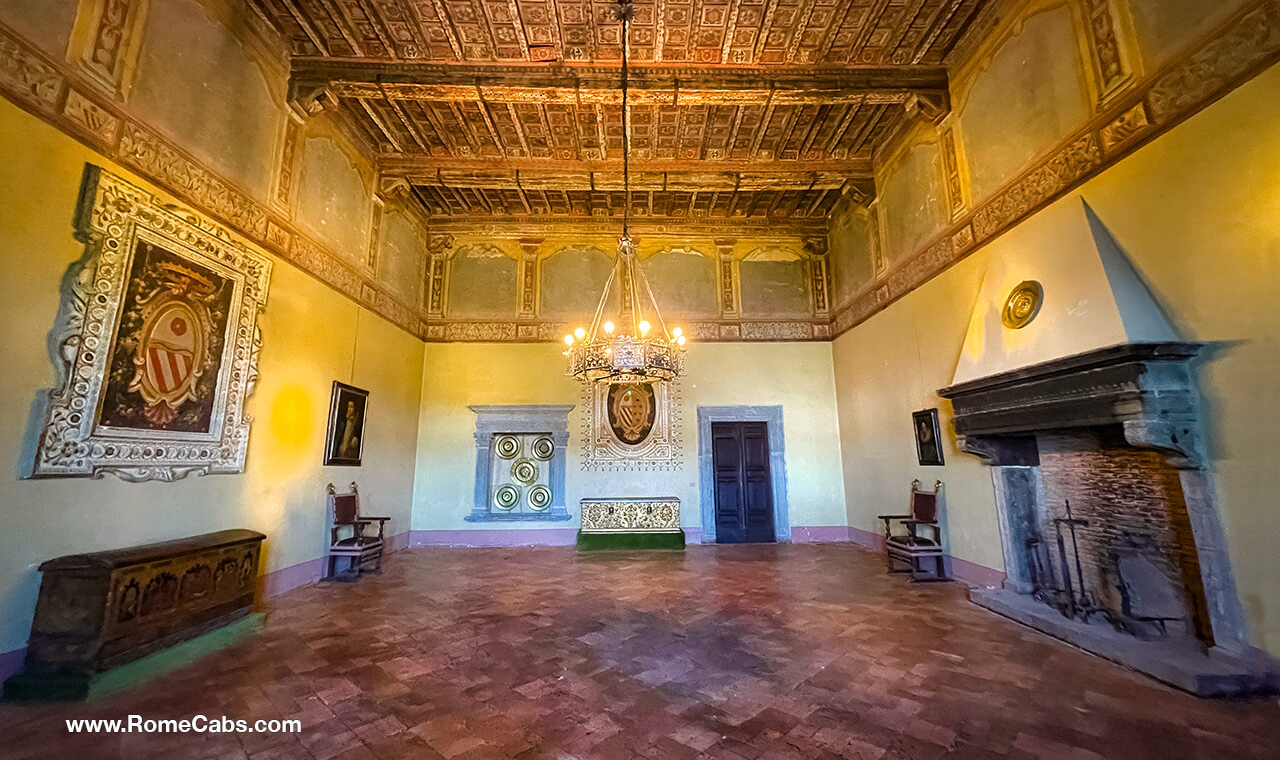
Hall of Caesars (Sala dei Cesari)
The Hall of Emperors stands as the centerpiece of Bracciano Castle. Not only is it the largest hall in the castle, but it's also conveniently accessible from the Court of Honor, making it the focal point for receiving important visitors who were greeted by a breathtaking view of Lake Bracciano through its expansive windows.
Adorning the room's perimeter are 12 busts of Caesars originally from the Villa Giustiniani Odescalchi in Bassano Romano. These busts were recently placed here by Livo IV Odescalchi.
Historically, this hall played a pivotal role in the transfer of power to the Orsini dukes of Bracciano. It was here that Virginio Orsini was formally presented to the vassals of the Duchy of Bracciano by his father, Paolo Giordano Orsini. They sat under an opulent leather canopy with gold fringes, while representatives from various fiefdoms genuflected before the young heir, offering precious gifts as a sign of respect.
In this hall, vibrant celebrations came to life with dances, theatrical performances, and sumptuous banquets. Paolo Giordano was known for orchestrating various amusements, including games, tournaments, and carnival masquerades.
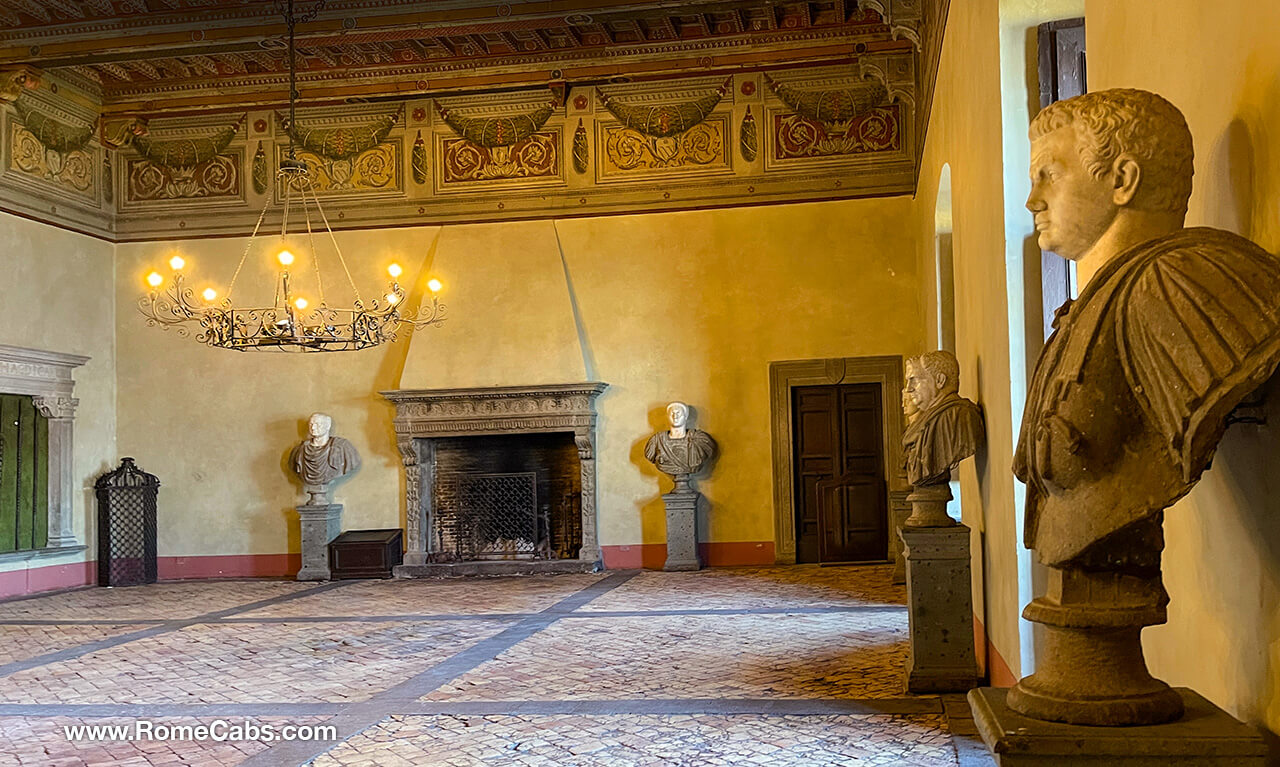
Hall of Women (Sala delle Donne)
The captivating frescoes adorning the upper walls of the Hall of Women vividly depict noble women engaged in various courtly activities such as singing, playing checkers, hunting, fishing, gathering fruit, and even preparing meals in idyllic rural settings.
Among these enchanting scenes, one above the fireplace portrays the legendary fountain of youth, while another on the opposite wall illustrates thermal baths. A different scene features two women bearing symbols associated with the Orsini family, seemingly involved in a hurried or defensive activity along the castle walls.
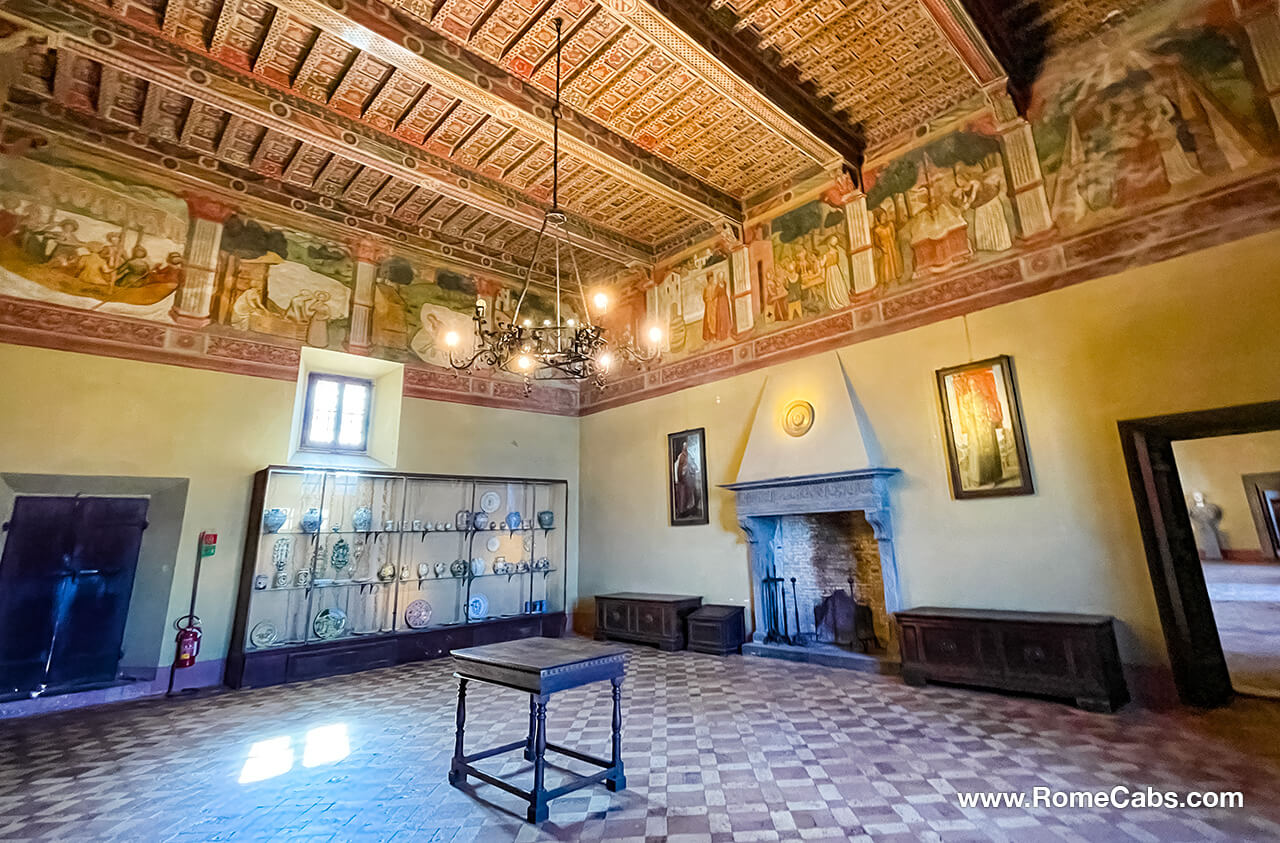
These scenes are accompanied by ancient female names, which, intriguingly, don't align with the narrative of the frescoes, adding to the mystery. While the identity of the painter, the patron, and the specific artistic style remain unknown, these scenes and names evoke the renowned writings of Christine de Pizan in her 1405 work, "The Book of the City of Ladies" (La Cité des Dames), which staunchly defends the role of women.
Given the room's association with women, it's plausible that these frescoes were commissioned by notable women residing in the castle. Possible patrons may have included Bartolomea Orsini, the sister of Gentil Virginio Orsini, who valiantly defended the castle against the Borgia attack in the late 15th century. Another potential benefactor could have been Felice della Rovere, the daughter of Pope Julius II, who, in her role as the governor of Bracciano Castle, was deeply immersed in the culture of the "City of Women".
Notably, two prominent 19th-century portraits placed in front of the fireplace depict Baldassarre Odescalchi and his wife Emilia Rucellai, portraying them as King Balthazar and Queen Sheba.
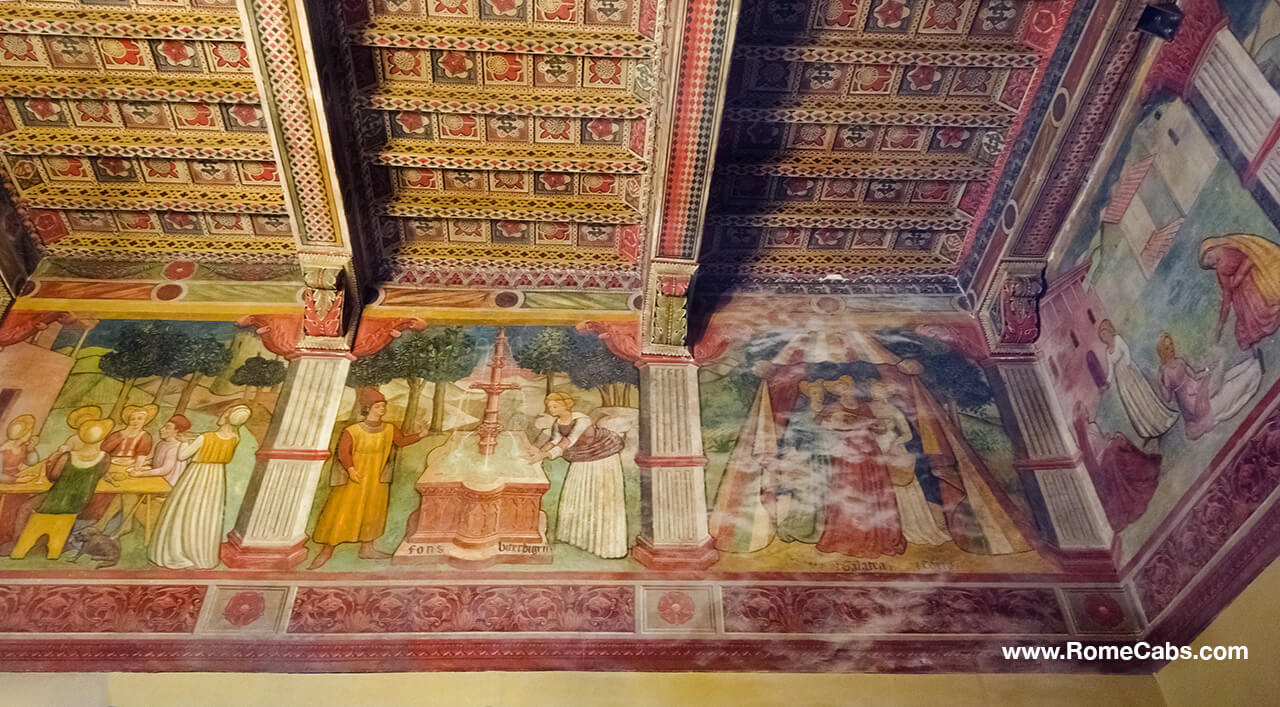
Hall of Paolo Giordano II (Sala di Paolo Giordano II)
The Hall of Paolo Giordano II exudes a Baroque ambiance and takes its name from Paolo Giordano II, the son of Duke Virginio Orsini, who received his education in the refined Medici court of Florence. He married Isabella Appiani, the Duchess of Piombino, and together they cultivated a Baroque cultural haven where music, art, poetry, and science thrived.
Paolo Giordano II notably acquired Galileo Galilei's telescope, established a printing house in Bracciano, and invented a musical instrument known as the "rosidra" in homage to Orsini's iconic rose symbol.
In this room, two striking marble busts are on display: one of Paolo Giordano II, crafted by the renowned artist Bernini, and another of Duchess Isabella Appiani of Piombino, sculpted by William the Flemish. These artistic representations, placed side by side, vividly capture the Orsini couple during the peak of their influence. Their shared passion for art and their roles as prominent patrons of Baroque culture bound them together.
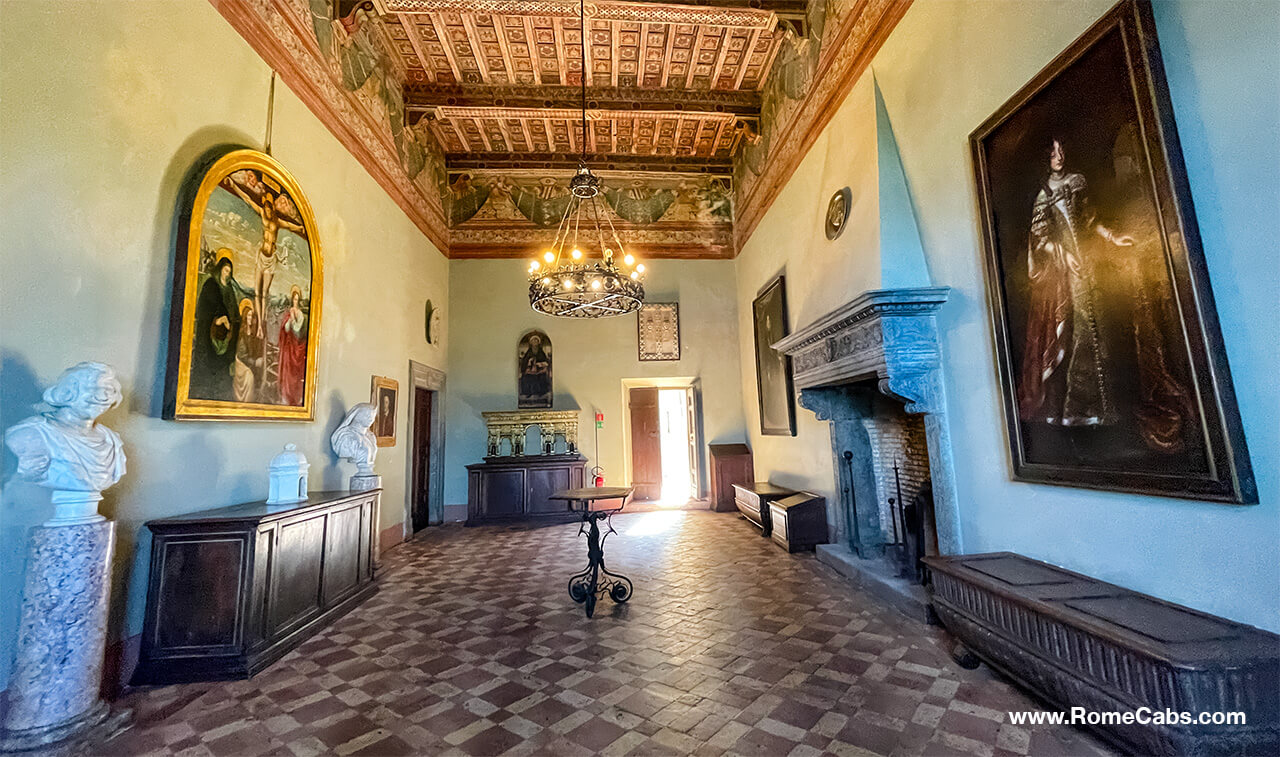
Queen Christina of Sweden
Additionally, a portrait of Paolo Giordano II's friend, Queen Christina of Sweden, graces this room. Queen Christina was exposed to philosophers, scientists, mathematicians, and artists from a young age. Her intellectual reputation intrigued the Duke of Bracciano, sparking an engaging correspondence that delved into various cultural topics.
Following her conversion to Catholicism, she relocated to Rome. The queen's inaugural trip to Italy presented the perfect occasion to reciprocate the Duke's unwavering and sincere friendship, marking it as a gesture of gratitude. On her way to Rome, she sojourned as a guest in the Castle of Bracciano in December 1655 during her birthday.
Sadly, the Duke passed away just five months later in May 1656, marking the end of the Orsini family's influence as newer Roman families began to rise to power.
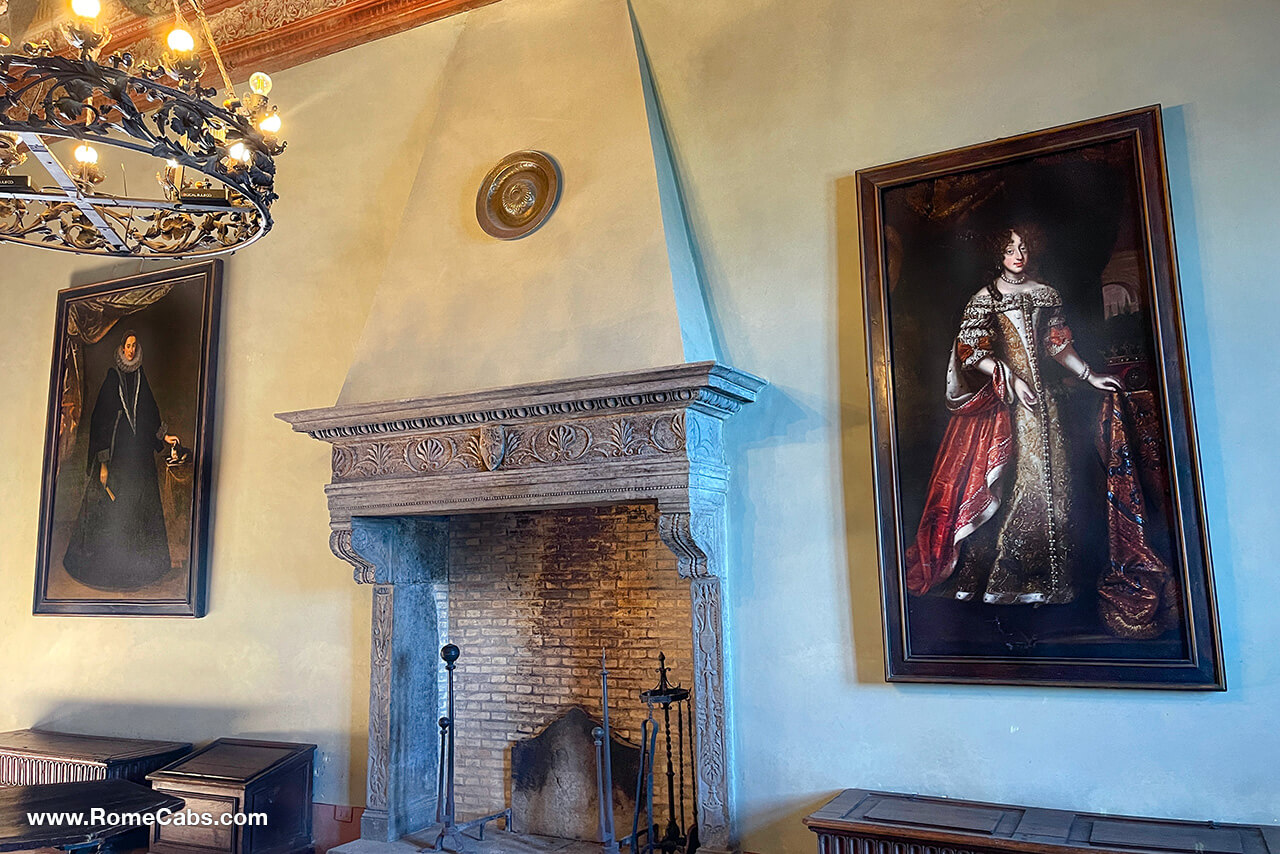
A New Era Begins: Transitioning from Orsini to Odescalchi
Paolo Giordano II's son, Flavio Orsini, facing debt and lacking heirs, became the last Duke of Bracciano. In 1698, he relinquished the title and fiefdom to Prince Livio Odescalchi, who was the nephew of Pope Innocent XI Odescalchi. A marble medallion and a portrait of the Pope in this room paid tribute to his role in this transition.
This marked the extinction of the Bracciano branch of the Orsini family and the passage of the castle into the hands of the Odescalchi family, who continue to own the castle to this day.
However, the Odescalchi family also faced challenges. During the French occupation, the Castle's valuable furnishings were looted. This event led to the Castle's sale, with the right of redemption, to the Torlonia family of Rome. Ultimately, in 1848, Prince Livio Odescalchi III successfully reclaimed ownership of the castle from Duke Marino Torlonia. His son, Baldassarre, a prominent figure in nineteenth-century Rome, oversaw a meticulous renovation of the Castle, restoring it to its former grandeur.
Hall of King Umberto I (Sala del Re Umberto I)
The Hall of King Umberto I is dedicated to King Umberto I, the second monarch of Italy, who, in the late 19th century, visited Bracciano Castle to pay tribute to the Odescalchi family.
The Odescalchi family had made significant contributions to the unification of Italy and the establishment of its capital in Rome. While this room bears the name of King Umberto I, its essence is steeped in the spirit of Livio Odescalchi.
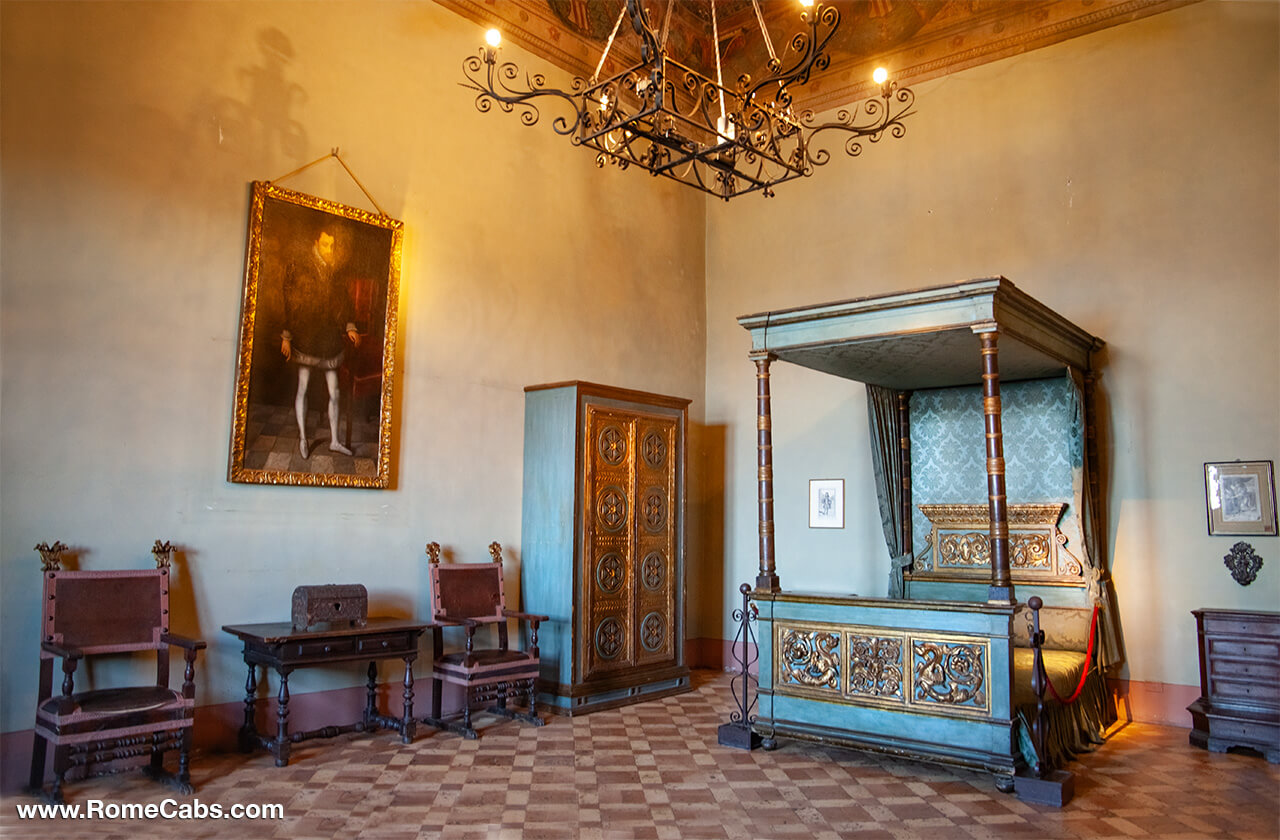
Livio, whose portrait is prominently displayed just above the fireplace, played a pivotal role in financing the expedition led by John Sobieski that decisively ended the Turkish siege at the Battle of Vienna in 1683. In recognition of his distinguished service in this battle, he received the titles of Imperial Prince and Duke of Syrmia, along with the possession of Ilok Castle, bestowed upon him by Leopold I, Holy Roman Emperor.
He was also granted the distinction of a Grandee of Spain. In 1696, Livio Odescalchi acquired the title of Duke of Bracciano and the renowned Bracciano Castle from the Bracciano branch of the Orsini family. He briefly considered candidacy in the Polish election of 1697 but was not elected.
Livio Odescalchi emerged as one of the most celebrated collectors of the seventeenth century, establishing his cultural and political autonomy through patronage and a series of artistic commissions that often pushed the boundaries of conventional artistic practices.
Hall of the Pope (Sala Papalina)
The Hall of the Pope is situated within the tower that houses the main entrance to the castle.
Although the precise purpose of this room remains uncertain, it may have earned its name due to its historical role in hosting Pope Sixtus IV for two months during the 15th century to escape the devastating plague that had struck Rome. Interestingly, in Italian “papalina” also means “skullcap”.
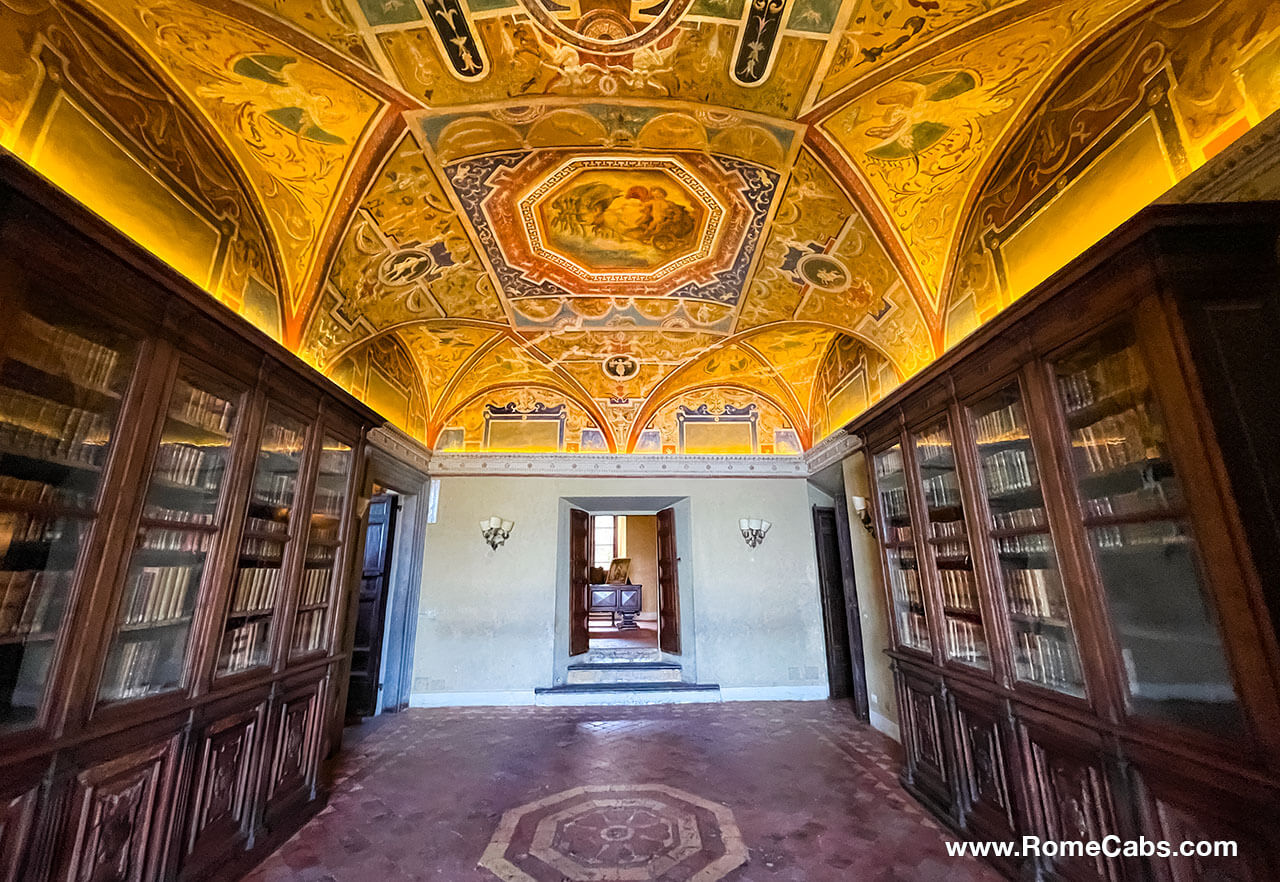
In 1560, the Zuccari brothers adorned the room's ceiling with frescoes, commemorating the union of Paolo Giordano Orsini and Isabella de' Medici. Judging from the exquisitely detailed ceiling iconography, it became a space that celebrated and represented the authority of Paolo Giordano Orsini during the 16th century.
Gazing up at the intricate ceiling, one will find a hexagonal medallion at its center, depicting the pagan god Apollo in his chariot, driving the rising sun from right to left in the image. Surrounding the hexagon are astrological signs, placed in unconventional arrangements. Leo and Cancer on the right side symbolize the summer solstice, while Capricorn and Aquarius on the left side signify the winter solstice. Apollo's movement towards Capricorn symbolizes the traditional beginning of the lengthening days between December and January.
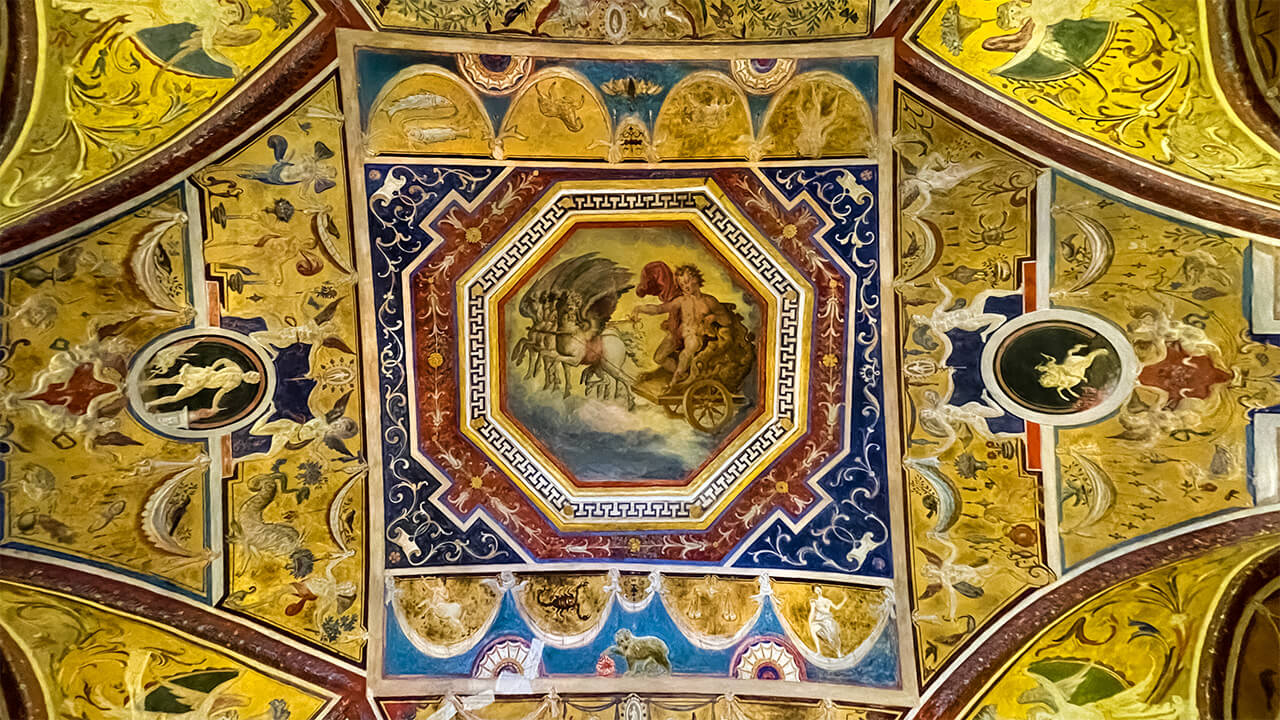
Notably, Paolo Giordano, the patron of the room, was born under the sign of Capricorn, and this sign is prominently displayed just above the entrance door. The ceiling serves as a tribute to Paolo Giordano, portraying him as Apollo, a figure born under the influential sign of Capricorn.
Studiolo of Baldassare Odescalchi
This small room, an annex to the Hall of the Pope, served as a study for Baldassare Odescalchi, approximately three centuries after the passing of Paolo Giordano and Isabella. In this modest studio, Baldassare found solace in penning entries in his travel journals.
Born in 1844 to Livio Odescalchi V and Princess Zofia Katarzyna Branicka, Baldassare held strong convictions against the temporal power of the Pope. He chose to live in exile in Florence, then Italy's capital, and became involved in the city's Republic Ministry. His return to Bracciano was motivated by the impending unification of Italy, and he took it upon himself to restore Bracciano Castle in the early 1900s.
Later in life, Odescalchi played a pivotal role in establishing the Industrial Art Museum of Rome. His early fascination with artistic subjects led him to author several works, including "The Museums of Art and Industry in Italy" (1871), "Of the Teaching of the Ornate" (1883), and "Impressions of History and Art" (1896).
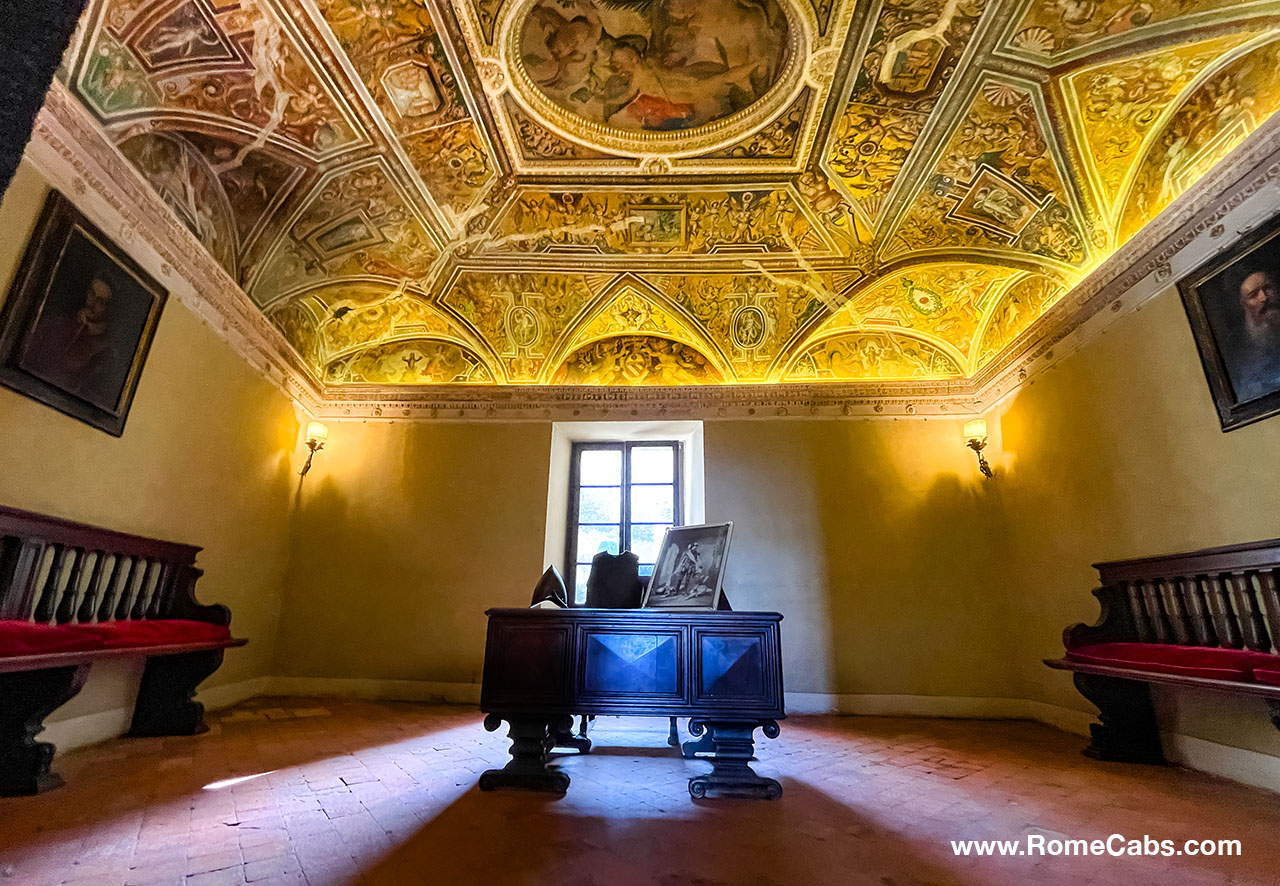
Since its opening to the public in 1952 under the stewardship of Livio IV Odescalchi, the castle has become a popular destination for visitors. It not only welcomes tourists but is also frequently chosen as a venue for receptions, various private and cultural gatherings, and weddings - including numerous high-profile weddings of Tom Cruise and Katie Holmes, Eros Ramazzotti and Michelle Hunziker, and Petra Ecclestone and James Stunt.
This concludes your visit to the castle. To exit, descend the spiral staircase back to the vestibule, pass through the portal door, and leave the castle through the main entrance.
